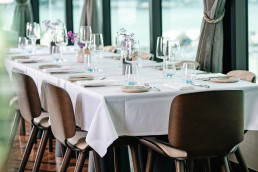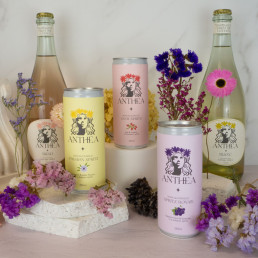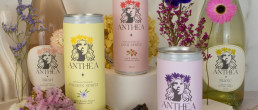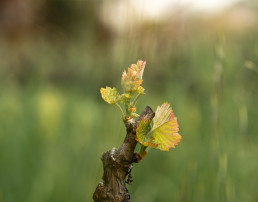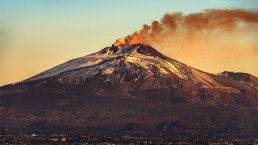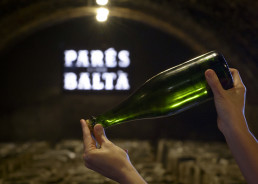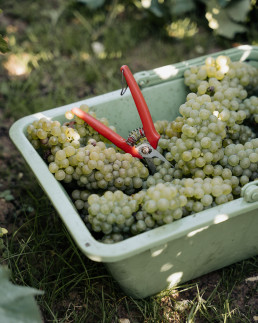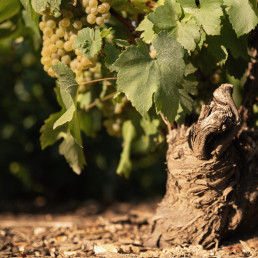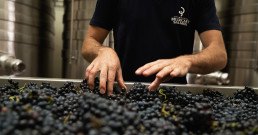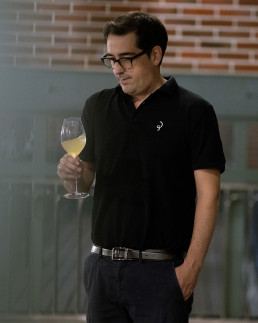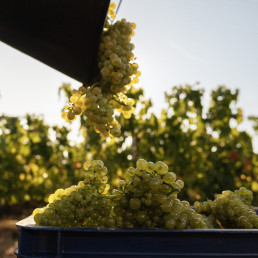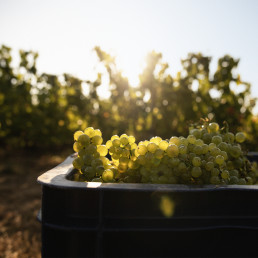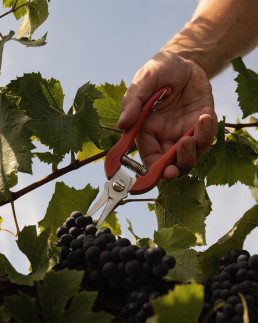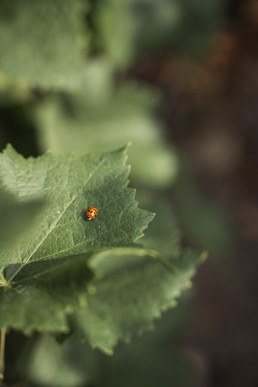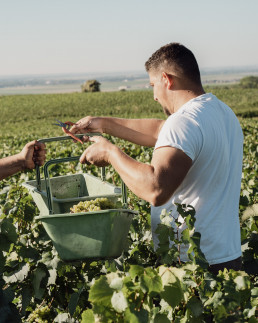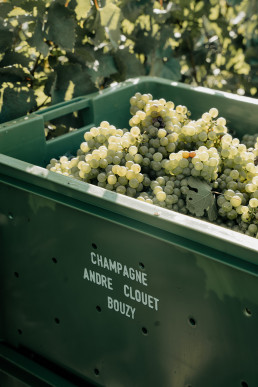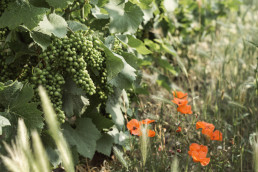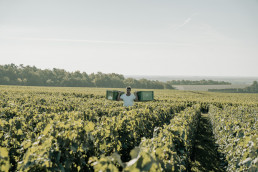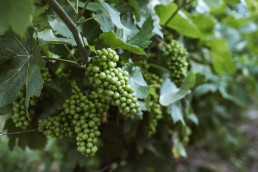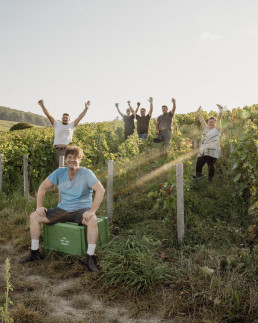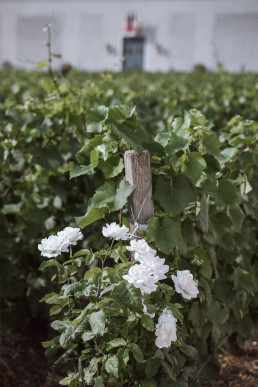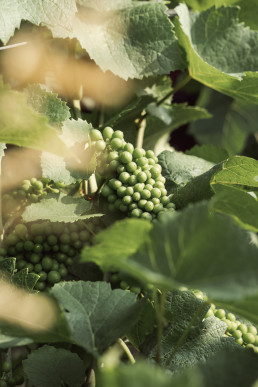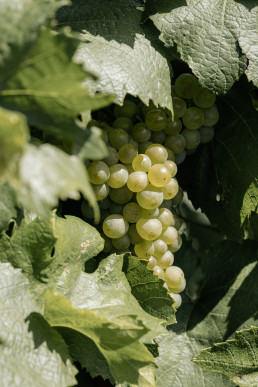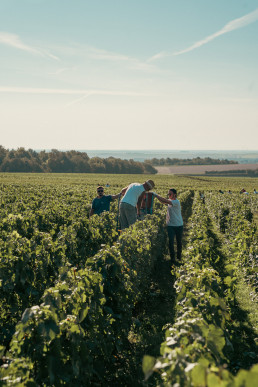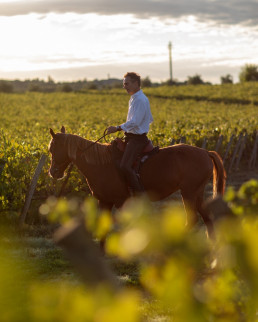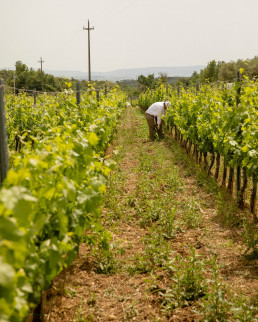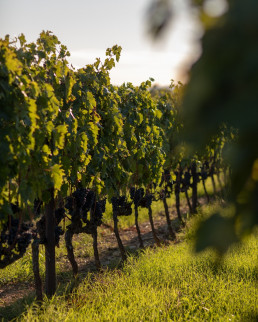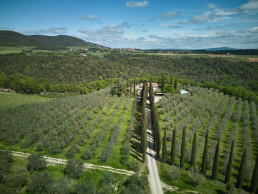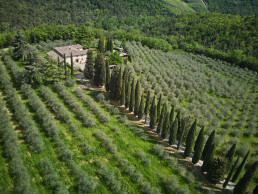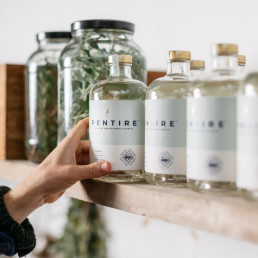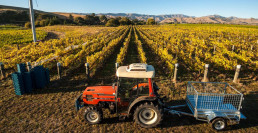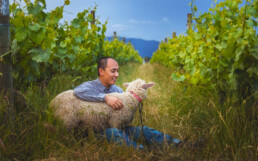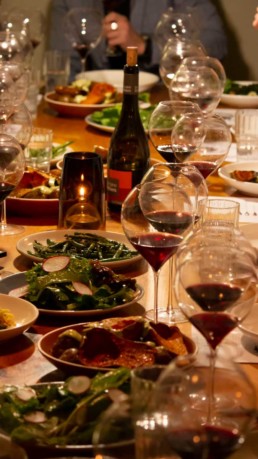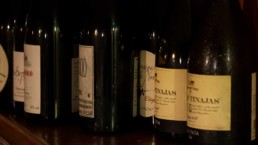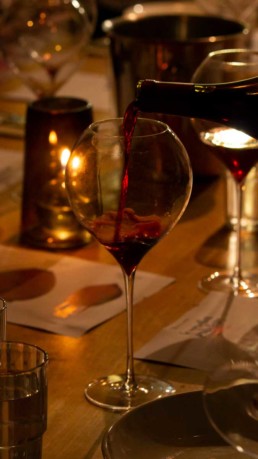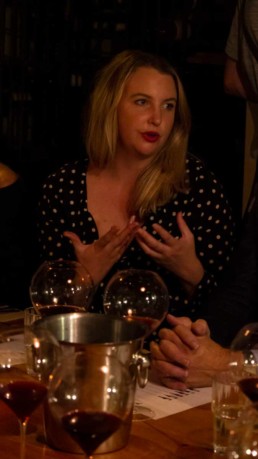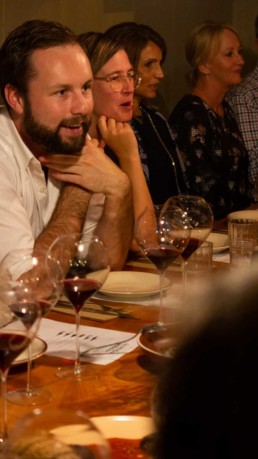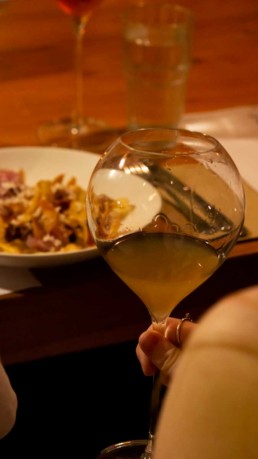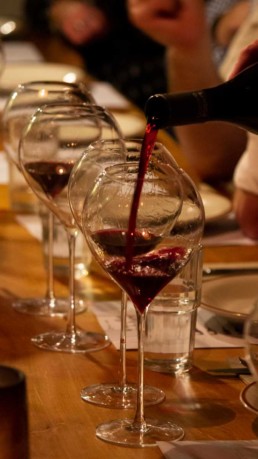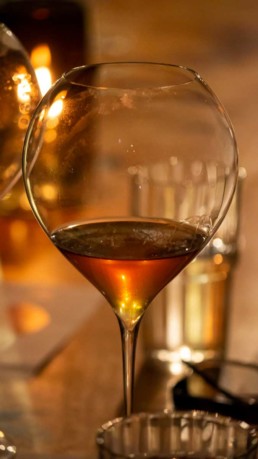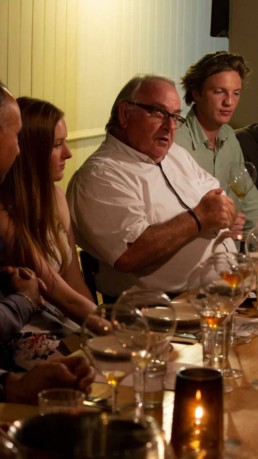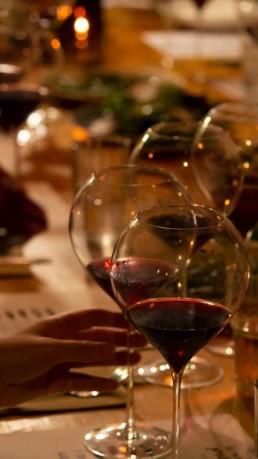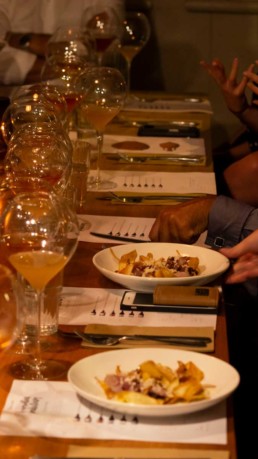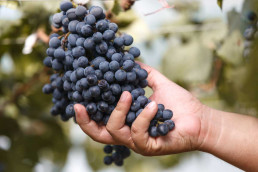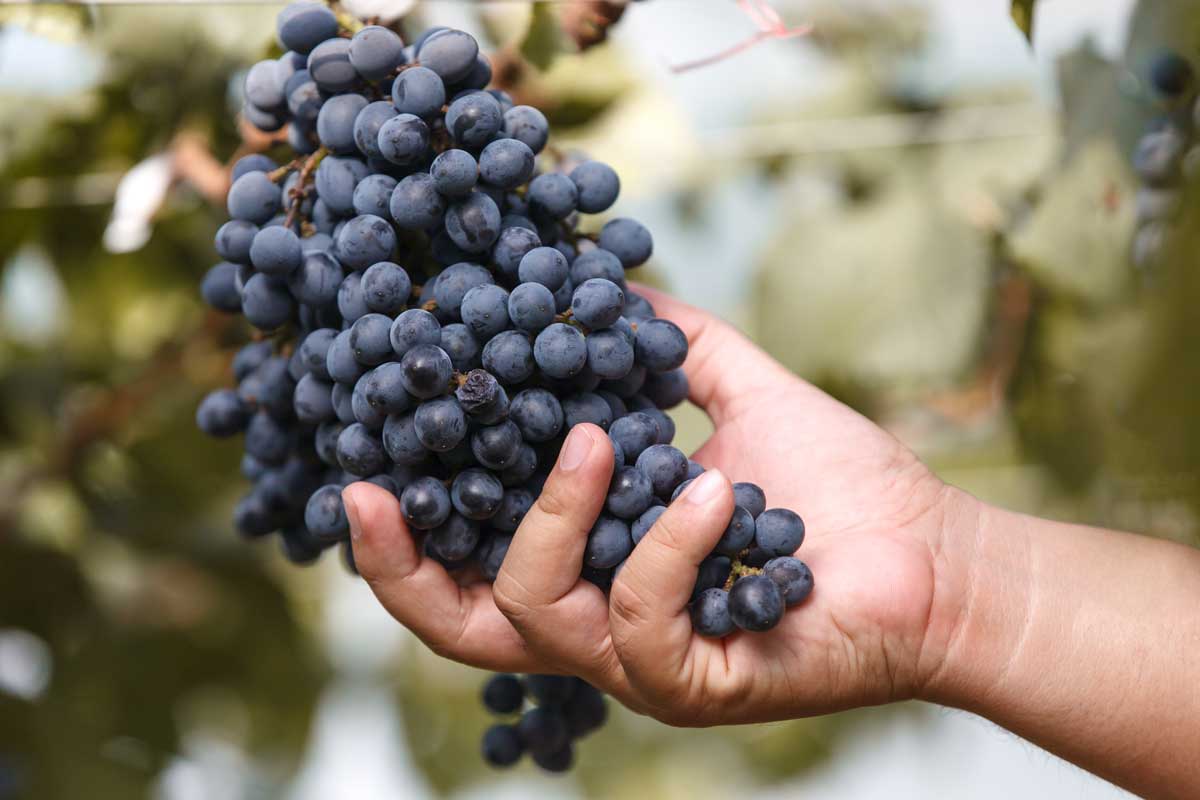Winery in the Sky - An Italian Wine Dinner 15 Storeys Up
Join Harbour Society and Dhall & Nash for a journey to Italy, 15 floors above Auckland City with a wine dinner like no other at SO/ Auckland.
Enjoy a two-course family-style sharing dinner while you sip, swirl and savour handpicked Italian wines by Mont’Albano. The plates will be a melody of woodfired food, straight from Harbour Society’s signature oven and will include meat and seasonal veggies.
Three wines from Mont’Albano will be the stars of the show, showcasing incredible varietals and styles to suit all palates. Mont’Albano was founded in 1985 in the heart of the Friuli Venezia Giulia region, with wines from Verona, Abruzzo and Sicily. They are dedicated to creating niche wines that happen to be organic.
A table with sweeping views of Auckland city, fragrant food and delicious wine will set the scene among good company.
- Date: Thursday, 31 October 2024
- Time: 6:00pm - 8:30pm
- Location: Harbour Society at SO/ Auckland
- Cost: $89.10 per person
Anthea: Your Newest Sober-Curious Crush
Listen… we love wine. Shocker, right? Who’d have guessed. But life is about diversity! Twisting things up every now and then is something we love to do, so when Anthea came across our radar, our ordinarily-wine-trained ears perked up.
Anthea is a brand new non-alcoholic option to the New Zealand market, offering delicious and refreshing alternatives to wine and spirits. For a long time, those opting out of alcohol have been relegated to the kid’s soft drinks section of the drinks menu, destined to order ‘just a coke, thanks,’ eternally… but this era is over. Bring on the rise of Anthea: The grown-up, refined choice that’s anything but boring.
About Anthea
Anthea (or Antheia) was the ancient Greek goddess of human love, flowers and nature. She was known for her role in bringing beauty and abundance to earth through the blooming of flowers. She was worshipped with offerings of flowers during festivals and celebrations dedicated to her.
Anthea takes inspiration from this goddess and her affiliation with nature and connection. Hand-crafted, Anthea drinks utilise the power of natural botanicals to hand-craft satisfying, complex and refreshing beverages that are kind to the liver but hit the reward-centres in our brains hard.
A Winemaker’s Touch
Anthea drinks have been developed and hand-crafted by Darren Webster. After a decade of boutique winemaking in New Zealand and California, he has turned his talents to the quest for non-alcoholic beverages with the enjoyment and complexity of a wine.
Working from Riverhead, New Zealand, he creates unique flavour combinations starting with real flora, herbs, and spices to create enjoyable warmth and complexity similar to great alcoholic drinks.
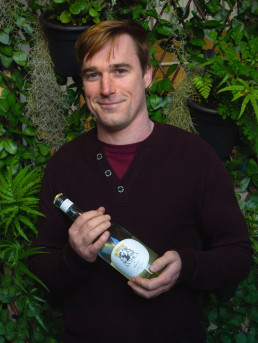
Why We Drink
So why do we like to drink? Let’s break it down…
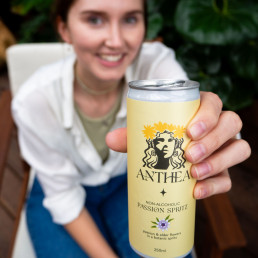
1. It tastes good!!
Simple as that. When drinking – whatever your order may be – we pick it because it tastes good. A hint of flavour here, a touch of bitter to offset it there… it’s all about when you take that first sip and go “ugh, yum.” According to the NY Times, (and we wholeheartedly concur), “a great non-alcoholic drink has all of the elements of a great alcoholic one”. Taste is very subjective, but there are key components that make a drink feel balanced, namely a harmonious blend of acidity, sweetness, bitterness, salinity, and water.
Anthea recognizes that those choosing non-alcoholic options aren’t always doing so for the fact they prefer the taste of a soft drink over say, a nice pinot gris with their pasta. (No hate if that is your preference though!) They often do this because soft drinks or juice are the only choices for them, and many consumers would love an alternative that isn’t so… kiddy.
Anthea drinks are dry/off-dry. There’s sweetness to them, but it’s far and away not their defining trait and in fact they’re very low in sugar. They’re flavoursome and complex, but not syrupy and are immensely refreshing. They hit all the keywords you want in a refined, proper drink, but with none of the alcohol.
2. It’s the Social Choice!
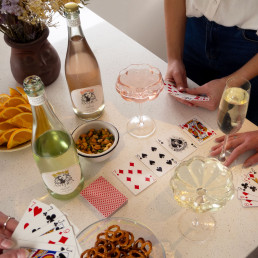
Many of us know that alcohol is often a normal part of our social interactions. “A box,” is fair tender for convincing friends to come over and give you a hand in the garden over the weekend and it’s almost unheard of to turn up to any dinner party without a bottle in hand (or at least our dinner parties…)
This normalisation can sometimes create an unwelcome pressure to drink. However, a lot of us want to reduce the amount we’re consuming or eliminate alcohol altogether. Deciding to ease back or eliminate alcohol is a very personal choice which we and Anthea understand and respect entirely.
“The [sober-curious] movement pushes back at the normalization of heavy drinking and stereotypes that those who do not drink are less social or have less fun,” explains Sarah Sheppard in their article ‘What does it mean to be sober-curious?’
3. It Helps Us Feel Good!
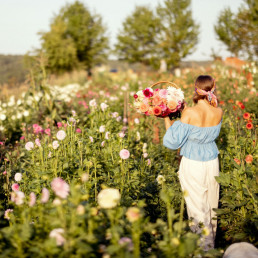
For anyone that’s ever experienced a hangover, you might know where we’re going here…
For nights where you don’t over-indulge though, there’s definitely something supremely relaxing about opening a drink, sitting down and just settling down for the night. It’s an unwinder for many people, and it’s a valid and measured vice for many responsible adults… but there’s no sticking our heads in the sand here. It can, in the long term, increase stress and sometimes dependency.
But… the ritual aspect of this practice does some heavy-lifting here. There’s more to drinking than the liquid itself – the act of selecting the bottle, opening it, hearing the pop/crack/ping and the gluggy sound of the pour all activate those reward centres telling you ‘it’s nearly time!’
We’re creatures of habit, and Anthea recognizes all these factors play into your imbibing experience. No supermarket plastic-bottles here! The Blanc & Blush Spritz’ come in 750ml glass ‘wine’ bottles, and the on-the-go spritzes have the ultimate satisfying can-plunk noise to get that dopamine going before you even get to enjoy the deliciousness. And believe us, it’s coming.
Health & Wellbeing

The elephant in the room with alcohol is overwhelmingly its effect on our health. Touched on briefly above, it’s something we can’t stick our heads in the sand about and something that we take notice of as a distributor of many fine wines, spirits and craft beverages. We always like to encourage responsible alcohol consumption when you choose to drink, and for when you choose not to, we want to make sure that your choices are equally as appealing and not patronising.
Anthea is not only non-alcoholic and delicious, but also;
- Low in sugar
- Low in calories
- Vegan-friendly
- Uses real botanicals including many with known health properties (eg. chamomile, goji, rosehip and lavender to name a few.)
The Facts & Numbers

“It’s a popular time to be sober. Interest in Dry January, a month when many forego drinking alcohol, has jumped 259% compared with the same period last year, according to an analysis by the food website Pantry & Larder.” Christina Campodonico wrote for The San Francisco Standard in 2023.
The Stats
(If you hated statistics class in school, you can skip this bit but let us data-heads enjoy some numbers and reports.)
Graziella Riant-Dalibard for Natural Origins starts off strong in her article, “According to the latest Fact.MR (1) report, “non-alcoholic spirits”, also known as 0.0, represent a market expected to reach $271 billion worldwide by 2033,” she explains, “The sector is very buoyant and has already seen its CAGR increase by 9.9% in four years to 2022, valued at $104.3 billion, the report states.”
Some people attribute the rise in popularity to the growing “sober-curious” movement, which tries to break the ‘norm’ of drinking not by shaming those who choose to drink but by welcoming anyone at any stage of their journey to celebrate it, whether they be ‘curious’ about cutting back or completely sober. The movement is all about not alienating those who switch it up and encouraging the personal choices involved… and it’s working. “The ‘sober curious’ movement is not just a fleeting trend. It’s a shift in the way people and generations are interacting with and thinking about alcohol use,” Nicole F. Roberts writes for Forbes Magazine, where she writes about global public health, behavioural science & innovation. “The percentage of college students aged 18 to 22 in the United States who stated that they refrained from drinking alcohol rose from 20% in 2002 to 28% in 2018.”
“It’s important to reiterate that being sober curious is different from sobriety. Choosing sobriety means abstaining from alcohol… On the other hand, being sober curious means reflecting on why, when and how you consume alcohol.”
Nicole F. Roberts, Forbes Magazine
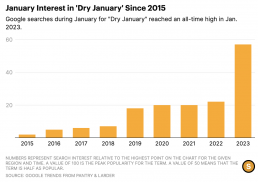
“It’s a popular time to be sober. Interest in Dry January, a month when many forego drinking alcohol, has jumped 259% compared with the same period last year, according to an analysis by the food website Pantry & Larder.” Christina Campodonico wrote for The San Francisco Standard in 2023.
The Market
It’s great to get the consumption trends from Stats NZ and the NZABC, but how is this reflected in the market? For both our on-and-off premise customers, you’ll be interested to know (and perhaps have experienced yourselves,) it’s definitely showing.
On-Premise
QT Auckland Food and Beverage Director Chad Mills spoke to Restaurant & Café NZ in July this year about the “Non-Alcoholic Resurgence.” Mills told them that having a decent non-alcoholic offering has become an expectation of his customers. “A simple soda or soft drink isn’t enough anymore,” said Mills.
Reflecting the public desire to enjoy non-alcoholic beverages not just at home but out and about are the number of lists being published by lifestyle publications. Media like Broadsheet, UrbanList, Stuff, and Denizen frequently publish pieces giving eager patrons tips on where they’ll find the best non-alcoholic options, highlighting those who’ve extended beyond the standard coke & juice choices many have come to expect.
Our research has also taken us into forums where we can see what consumers are talking about – straight from the horse’s mouth. Internet hub, Reddit, has an active community sharing interest in all sorts of topics, including recommendations from peers around where they should be heading. Check out a few below if you feel like a social media dig, or to have a nosy as to whether your establishment gets any shoutouts:
- “Are there restaurants with non-alcoholic wines or can I only get Byo’s?” in r/auckland
- “Restaurants/bars with good non-alcoholic options?” in r/wellington
- “Non-alcoholic drinks at Bars” in r/wellington
- “0% Wine – Why do no bars stock it here?” in r/chch
- “Non-alcoholic wine & beer at any bars / restaurants in Welly?” in r/wellington
All of this to say – consumers are thirsty for more non-alcoholic options that are delicious, socially accepted and not condescending or boring. We believe Anthea offers a sophisticated and fun option for those sober-curious, completely sober, or just wanting something a smidge on the lighter side.
Off-Premise
FMCG Business earlier this year broke down the Circana’s latest liquor report, which pulls together grocery store sales and combines these with national statistics on liquor store sales, alcohol production and consumer survey data to build a comprehensive view of liquor trends and consumer behaviours. “Alcohol consumption in New Zealand is declining… it raises some important questions.”
“One explanation comes from the grocery market. According to Circana’s grocery market data, total alcohol sales have fallen 1.8% in volume in the past year. Once the second highest performing department, Alcohol has been relegated to fifth place – behind non-alcoholic beverages.”
The last few years has also seen the first Alcohol-Free Bottle Shops, dedicated entirely to providing 0% alternatives to the sober-curious consumers out there. Concrete Playground reported on Auckland’s first, The Curious AF Bottle Shop when it first opened in late 2022, where they threw shade at the state of offerings at the time, “the stunning space gives an insight into just how expansive the international alcohol-free drink selection is these days — and shows just how few excuses our country’s bars and restaurants have for offering nothing better than lemonade.”Since then, other outfits such as The Chiller, an online shop based in Auckland have popped up with extended ranges of 0% options.
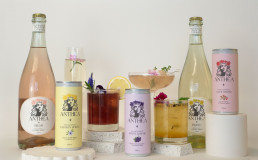
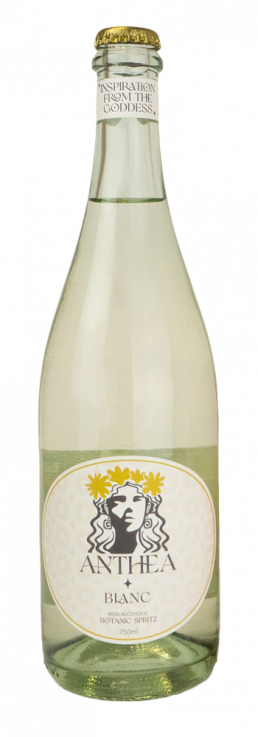
Anthea Botanical Spritz Blanc 750ml bottle
Prosecco or bubbly alternative. Crafted with botanicals including Honeybush, Thyme, Lemon Balm and Chamomile. A seductive bouquet of peach and apple, complemented with floral and honey notes. Wonderfully fresh, with a creamy mousse, and a crisp, dry finish.
- Available in 6 Packs
- <0.5% Alcohol (Less than bread!)
- Vegan-friendly
- Made in NZ
- Low Calorie
- Low Sugar (5g per 125ml glass)
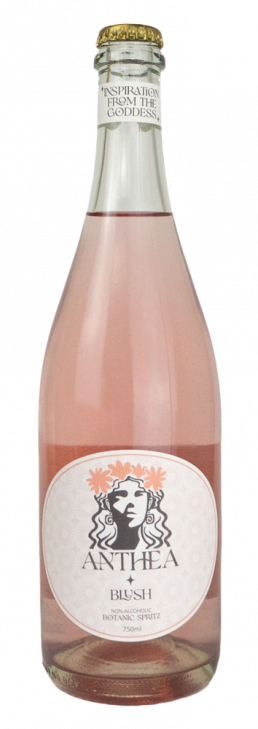
Anthea Botanical Spritz Blush 750ml bottle
Is there ever an occasion a pink bubbly is not perfect for? Blush is crafted from a blend of Schisandra berry, Rosemary, Lemon Balm and Thyme. A vibrant bouquet of strawberries & cream, underpinned with complex savoury notes. Followed by a round body with balanced acidity and satisfying finish.
- Available in 6 Packs
- <0.5% Alcohol (Less than bread!)
- Vegan-friendly
- Made in NZ
- Low Calorie
- Low Sugar (5.6g per 125ml glass)
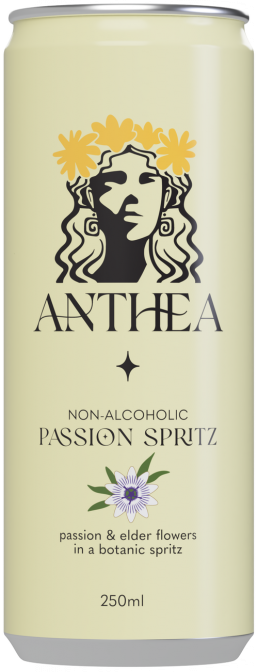
Anthea Passion Spritz 250ml can
The Passion Spritz offers an elegant floral flavour, driven by notes of passionflower & elderflower – leading into the ripe, fleshy fruit of the botanic spritz base. A crisp minerality on the palate, leading into a clean & dry finish.
Drink on its own, or elevate your Passion Spritz by pouring over ice, top with a scoop of fresh passionfruit and garnish with a sprig of mint and edible flowers.
- Available in 24 Packs
- <0.5% Alcohol (Less than bread!)
- Vegan-friendly
- Made in NZ
- Low Calorie (43 per serve)
- Low Sugar (10g per can)
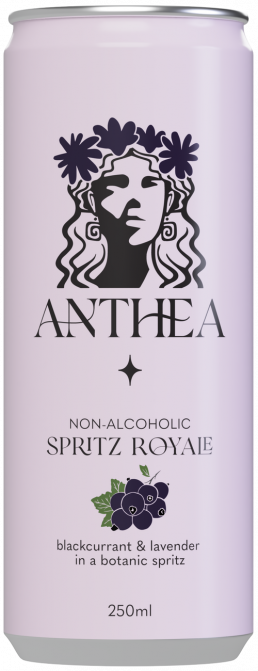
Anthea Spritz Royale 250ml can
The Spritz Royale offers bold and lively flavours of blackcurrant, balanced with a hint of lavender. A delicious, textural experience with a rounded & fruity finish.
Drink on its own, or elevate your Spritz Royale by pouring over ice, add a wheel of lemon and garnish with fresh lavender or edible flowers.
- Available in 24 Packs
- <0.5% Alcohol (Less than bread!)
- Vegan-friendly
- Made in NZ
- Low Calorie (44 per serve)
- Low Sugar (10.4g per can)
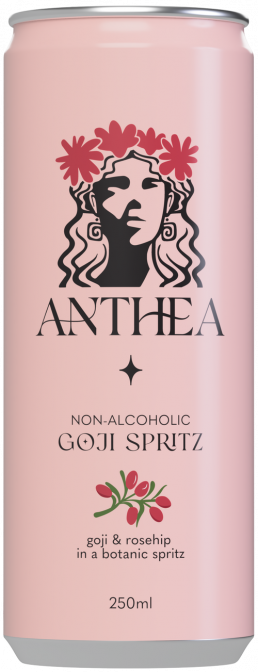
Anthea Goji Spritz 250ml can
The Goji Spritz offers vibrant pink berry aromas of goji, underpinned by soft & velvet rosehips. The bright, fruity flavours combine with the fresh notes of the botanic spritz base for a crisp, dry finish.
Drink on its own, or elevate your Goji Spritz by pouring over ice, adding peach slices and garnish with a sprig of thyme & edible flowers.
- Available in 24 Packs
- <0.5% Alcohol (Less than bread!)
- Vegan-friendly
- Made in NZ
- Low Calorie (43 per serve)
- Low Sugar (10g per can)
Focus On: Organic Wines
Focus On: Organic Wines
Do the right thing for the Planet - drink organic
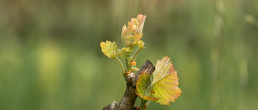
‘Mother Nature knows best’. ‘Eat well to feel well’. ‘You are what you eat (and drink)’. These age-old truisms certainly portray todays catch cry for healthier living and save-the-planet awareness. Is Organics in wine though just a fad or is it the future? Or is it something that we need to embrace and now as increasingly, the younger generation ardently pressure us to believe. Here at Dhall & Nash it’s often been a subject of lively discussion. Can you taste the difference? Is it worth the cost of certification? What do you think? Let’s take a look at Organics in the world of wine.
We get it – wine is, in its simplest form, a celebration of all that nature has the power to produce. So why spoil natural perfection with pesticides and chemicals some may question – particularly those in the on-trend Natural wine movement. Organic proponents suggest that by choosing organic wine, you can experience all the goodness of nature, with none of the environmental cost. But is it that simple?
“ORGANIC VITICULTURE ROCKS! It’s the future, it really is.”
Steve Wratten, Professor of Ecology at Lincoln University
How The Stats Stack Up
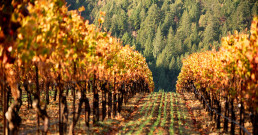
Globally, wine consumption is flat-lining! Down 3.6% in 2020 (according to OIV The International Organisation of Vine + Wine). Despite this flat global wine market, organic wine may offer a bright point for the wine industry. Certified-organic wine volume consumption has increased close to 9% on average a year (2014 to 2019). This has been backed by an exponential increase in certified area under vine (and in conversion), particularly in Italy, Spain, France, Australia, and NZ. Globally, organic’s share of total wine consumption currently sits at 2.75%. This is expected to climb to around 4% by 2024 (IWSR – International Wines and Spirits Record UK).
Looking ahead, it is expected organic wine will command an increasing share of total wine consumption. In the US, for example, a growing Ecommerce and Direct To Customer segment is helping to bolster the momentum of organic, biodynamic, and low-intervention wines. In Italy, for example, a new wave of organic and IGT-certified Tetra Pak wines is targeting younger consumers interested in eco-friendly and quality wine at a more accessible price point. They are using packaging and branding to highlight quality and environmental cues to their target consumers. Significant change is afoot.
“Organic and biodynamic viticulture is no longer a niche oddity.”
Jancis Robinson MW
Getting Down ‘n’ Dirty in the Vines
There’s a circle of life in the vineyard: It all begins with the relationship between the soil and the vine. A great wine is a living wine and the life of that soil must be nurtured as it will transmit its life force to the vine. The life force of the vine, in turn, must also be nurtured, as it returns that life to the soil.
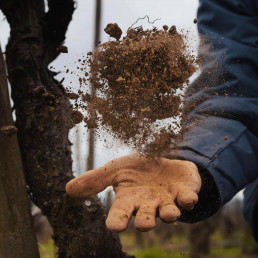
“The wine industry is very proud of its relationship with soil, but the truth is, it’s a spurious one” explains Wine Writer Tamlyn Currie. It’s true. The wine world and us passionate wine consumers so often obsess about terroir, mistaking that obsession for love of and respect for vineyard soils. But the sad truth is that one specific part of magical terroir, i.e., soil type, is irrelevant if that soil is dead, non-functioning, unable to do its real job.
Still conventional winemakers continue to use herbicides, pesticides, chemical fertilisers, and other synthetic sprays to protect their crops on a regular basis. For the main part, the production of wine is often as formulaic as the cultivation of wheat: water + chemicals + plants = profit. Does it need to be so for a precious liquid we revere and imbibe?
Now, we’re all aware of the danger that toxic chemicals pose to the environment. But what many of us don’t know is that this poisonous practice is just as harmful to us, as consumers. When farmers spray herbicides and pesticides onto their vines, these chemicals end up being absorbed by the vine, the soil, then altering natural pH content, killing wild biodiversity, and polluting nearby waterways. But that’s not all. They also end up in our food chain and maybe into our wines!
Further the practice of removing plant cover (with herbicides and ploughing) is basically skinning the earth alive. Plant cover is the planet’s ‘hide’. Among so many other ecosystems that plants provide, when it comes to vineyard soils, plant cover is crucial for regulating soil temperature, preventing soil erosion, regulating evaporation and water retention, fixing nitrogen, building essential structure which helps with drainage, nutrient transport, and oxygenation.
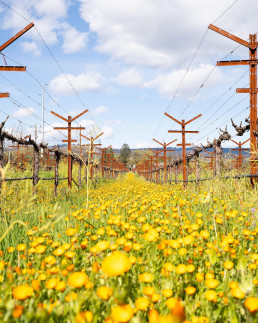
We haven’t even begun to understand the extent to which fungicides, pesticides and herbicides are damaging subsurface animal and microbial life, as they are sprayed onto plants and soak into the soil with rain and irrigation. But extensive research has been done and is ongoing on the damage being caused by nitrogen fertilisers; most of it is not even bioavailable and therefore is not taken up by plants. Ironically, the practice of feeding our soils is, in fact, polluting them. There must be a better way forward…
“Grapes are one of the fruits with the highest level of pesticide residues. Unfortunately, they don’t miraculously lose these residues as they arrive at the winery.”
Caro Feely, Wine Writer, JancisRobinson.com
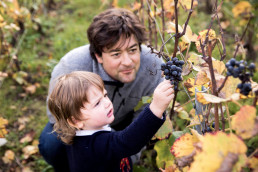
Choosing to buy organic wine is not just about avoiding the health implications of pesticide residues. It’s also good for the environment – which goes beyond the birds and the bees to include the people who live where grapes are grown and wine is made – winegrowers and vineyard workers, communities that live nearby and drink the water that runs off the farms.
The Do’s and Don’ts of Organics
Organic vineyards are not allowed to be sprayed with any synthetic chemicals: instead, these committed ‘woke’ winemakers turn to nature for inspiration. By embracing eco-friendly practices, organic farmers successfully subdue pests and disease in their vines, while simultaneously forming a sustainable self-regulating ecosystem that eliminates the need for artificial agents. Nice ☺
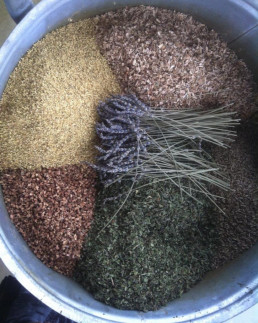
Here are a few ingenious ways in which organic farmers are forging the environmental way forward.
- Using natural animal predators to control insect pests and weeds: e.g., ducks, geese, chickens, sheep
- Using ‘enemy’ insect species to control parasites through natural predation.
- Growing of deterrent plant species in between vines to prevent plant-borne diseases (companion planting).
- Rotating different plants to nourish the soil, by restoring the correct pH balance and nutrients of the surrounding earth (crop rotation).
- Feeding vines with natural nutrient-boosters, like compost, green manure, seaweed etc.
- Planting ground-cover plants alongside vines to prevent soil erosion, to stabilize the landscape and to stop nutrients being leached out of the topsoil by rainfall/irrigation. They also limit their water usage by using mulches and monitoring soil moisture levels
- Creating an ‘ecosystem’ farm: designing a natural balanced vineyard system of sustainable, inter-supportive biodiversity i.e., an interactive community of animals, insects and plants living in balance.
“Organic grape growing, and the certification is no longer a marketing tool but a belief system.”
Tamlyn Currin, Wine Writer
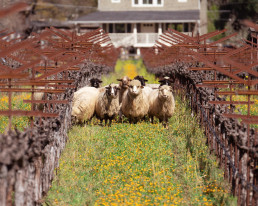
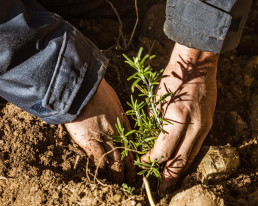
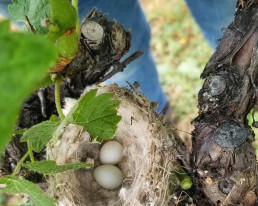
What Can Be “Added” in Organics?
As shown above, the organic viticulturist has preventive measures as his primary weapon against pests. He tries to prevent problems by being observant and attentive and manage the vineyard so that it can withstand attacks. Keeping the foliage aerated so that it dries up quickly after rain is, for example, one important tool. However, there are naturally occurring ‘chemicals’ that he can utilise in his vineyard and on the vines and still be organic.
Copper and sulphur are two products that are widely used in organic farming. In the vineyard they are the most important substances and are widely used both by organic growers and non-organic growers. Today, the use of copper is perhaps the most hotly debated subject in connection to organic agriculture and much research is ongoing.
Having to spray with copper is one of the great concerns for many organic growers. Copper is a heavy metal that in higher concentration can be toxic to the soil and to water. What is considered “high levels” and exactly how toxic copper is has been discussed for a long time, and still is. The European Union has, on several occasions, been close to banning copper in agriculture. It hasn’t done so yet, to the relief of all organic wine producers.
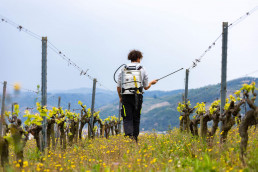
However, farmers are not allowed to use as much copper as they want. Until January 1, 2020, in the E.U. the permitted quantity was 6 kilos of copper per hectare a year. Now the limit is 4 kilos per hectare a year. Which some producers in humid climates think is on the low side. (The limit is now calculated as an average of the usage over seven years.)
Almost all vineyards around the world (particularly in humid regions like Bordeaux or West Auckland) are attacked to a greater or lesser extent of one or both of two potentially very devastating diseases: powdery and downy mildew. They are sometimes referred to by their French names oidium and mildiou. This is where copper and sulphur come as saviours for the organic grower. Otherwise fungal disease could wipe out entire vintages. Left untreated, it can even kill grapevines.
Copper is used to fight the sometimes very troublesome disease downy mildew (mildiou). It is a fungal disease that attacks the vine’s twigs, leaves, or grapes. Downy mildew can attack the vineyard throughout the growing season if it is humid. In difficult years you have to spray the vineyard many times.
Powdery mildew (oidium) is another potentially devastating fungal disease. It thrives if weather is warm/hot and humid. The organic growers, and also conventional ones, spray with sulphur. Sulphur is not as controversial as copper. But that does not mean that it is entirely safe. Certain small insects that are good to have in the vineyard, such as typhlodromes, can be harmed.
Organic producers can only use products that act by “contact”. This means that these products are sprayed on the surface of the vine and remain on the leaf or the grapes after treatment. They are effective as long as they are in contact, naturally rain washes them off.
There may be some hope on the horizon, though: numerous trials around the world are testing whether new, organically acceptable fungicides could supplement or even one day replace copper altogether. This research is still a work in progress.
What Happens in the Cellar?
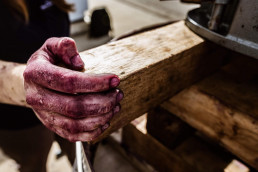
When it comes to the winemaking process, organic wines have much lower levels of sulphur and numerous other additives. There are 100’s of things that are legally allowed to be added to wine, the effects of which are not really known. Many are synthesised chemicals and additives that could potentially alter the taste and texture of a wine.
Sulphites are a common additive used as a preservative to stop the wine from spoiling. Sulphites aren’t altogether bad. They can preserve a wine’s shelf life, colour, taste, and freshness, but some people do have adverse effects to them. Organically certified wine has a limit to the amount of sulphites it can contain and keeping under this limit requires concerted effort.
Just to be clear – wine completely without sulphites doesn’t exist since these compounds are a natural by-product of the fermentation process. The main concern is whether or not sulphites are naturally occurring or chemically created. These compounds are measured in parts per million (ppm). Here’s the breakdown according to the USA organic regulations:
Conventional wine: Up to 350ppm
“Made with organic grapes” wine: Up to 100ppm
Biodynamic wine: Up to 100 ppm
Certified organic wine: Up to 10 ppm (only naturally occurring – nothing added)
Meanwhile, just to be confusing, in all EU countries the use of sulphites is allowed: wine could be considered “organic” if the wine is made with organic grapes and sulphite level is below between 100 and 150 parts per million (ppm), or 100 to 150mg/L, at bottling.
By the way – while there’s a common assumption that sulphites are to blame for everything from headaches to hangovers, studies show that tannins, histamines, and level of alcohol are much more likely to cause unwanted reactions. And don’t forget that unlike organic or biodynamic producers, commercial winemakers use dozens of undisclosed ingredients that could potentially cause side effects. Drinkers beware!
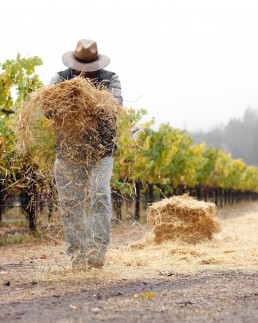
What are the differences between Organic, Natural and Biodynamic Wine?
Very broadly speaking, winemaking falls into two categories – conventional and organic. Beyond that, things start to get blurry. You’ve probably hit terms like ‘natural’, ‘biodynamic’, ‘minimal intervention’, ‘sustainable’, and ‘preservative free’ – some of these terms many in the biz can’t agree on a definition. There’s a lot to decipher, and when you’re staring at a wine list or standing in the aisle staring at a wall of wine it can fall into the too-hard-basket.
Briefly, we’ll give it a whirl here – with Natural wine basically, there are No Rules people, yep, no rules! (Except in France from 2020 where the government has approved a legal definition of natural wine and created a new category called vin méthode nature). Elsewhere in the world, Natural wine is unregulated, unpredictable, unfiltered, and made with minimal treatments in the winery. While there are technically no rules, most natural wine grapes are grown by small-scale, independent producers, hand-picked from sustainable, organic, or biodynamic vineyards, the wine is fermented with no added yeast, no additives are included in fermentation and little or no sulphites are added. Since this is a loose set of qualifications the quality of these wines can vary immensely but of course ask for recommendations to find some super funky and fun natural wines!
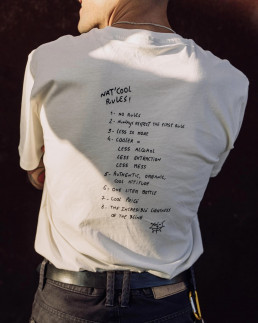
Biodynamic growers follow the same standard practices as all organic growers. On top of those practices, biodynamic growers use special plant, animal and mineral preparations, and work closely with the rhythmic influences of the sun, moon, and planets to maximise the natural potency of their land (see our Biodynamic blog here).
“the absolute key thing was reassuring growers that, yes, organics not only works but works really well in New Zealand and will allow us to maintain our hard-won image of premium quality.”
Bart Arnst, Organic/Biodynamic vineyard specialist, NZ
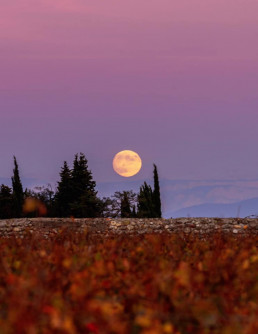
The other trending buzzword out there confusing us punters is ‘sustainability’. Good old New Zealand is a leading light in wine industry sustainability. Our country’s wineries first made sustainable wine headlines when they announced their ambitious plan to be net carbon zero by 2050. New Zealand was also the first to develop a nation-wide sustainability certification programme: Sustainable Winegrowing New Zealand™ (SWNZ). Today, a whopping 96% of New Zealand’s vineyard area is SWNZ certified. At the producer level, sustainability means crafting quality wine, in an economically viable and socially responsible manner, while protecting the environment for future generations.
The Organic Creds
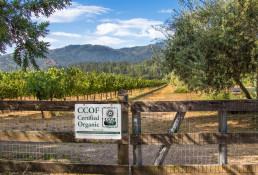
Ironically those who are not polluting have to pay to be certified while those who are using toxic systemic chemicals are not controlled and pay nothing. To our way of thinking, maybe it should be the other way around! Organic certification should be free and those using systemics should have to pay to be controlled so that we know they are using these products in the correct way and within the permitted levels. Not too revolutionary wouldn’t you think?
Anyway, in NZ, for a wine to call itself organic it has to have an official tick of approval from an independent third-party. BioGro and AsureQuality provide internationally recognised organic certification here. Biodynamic producers in New Zealand are certified by Demeter New Zealand. An arduous, multi-year certification process and yearly audits ensure that the whole winemaking process – from growing to bottling – complies with strict standards.
It’s true, there are wines out there made with organic processes that aren’t certified. Perhaps they’ve used organic grapes but topped it up with a man-made preservative that kills its eligibility. It is often the case that many small producers can’t afford the certifications, and others forgo this regulatory distinction for political or philosophical reasons or plain old time constraints. There’s many great wines and makers that fall into this group, but without that official sign-off, you’re relying on the honesty of the winemaker to truly do what they say. And remember, organic doesn’t equal vegan or added preservative-free. If that’s what you’re after, make sure you see those words specifically.
“[] strong microbial connection is what is important for the individual character of a wine – the true individual expression of the land – ‘terroir’. That’s what great wine is!”
Clive Dougall (Chairperson of OWNZ & Winemaker Deep Down Wines)
Is Organic Wine Better For Me? Does it Taste Better?
Wow! That’s the million-dollar question. Some argue it’s better to only put totally natural things into our bodies, but that doesn’t mean non-organic wine is bad for you. In fact, by a very large margin, most of the wine we drink isn’t organic and there’s very little research to say that that’s a problem. But it’s certainly a better choice for the planet, and given that’s where we live, that’s nothing to be sneezed at.
For a lot of folks, drinking organic wine just comes down to taste. If you’ve ever grown your own tomatoes, you’ll know what we mean when we say that organic produce has a certain vibrancy, and it can be fun to taste things just as nature intended. But as with anything else, organic doesn’t guarantee better quality. Just like non-organic wine, the calibre varies wildly and is all about your personal preferences. The best thing to do is get sipping and find out what you like for yourself.
Does Organic Equal More Expensive?
Yes and no. Organic grapes are at the mercy of the elements and take a lot of labour to protect. Lower yield (aka fewer usable grapes) means limited batches of wine, plus there’s the hefty certification costs to factor in.
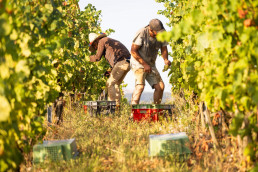
Many organic wines are truly artisan, handmade products and sometimes you might see this reflected in the price. But while that was true of nearly all organic wine five or ten years ago, that’s certainly not the case nowadays. As it becomes more accessible, so do the prices, and today’s drinker can easily find a solid bottle of organic good stuff that doesn’t hit the wallet hard.
Case in point, the wine coming from NAT COOL by Niepoort in Portugal is bottled proof that organic wine can be both remarkable and affordable. Or the organic Cristom Pinot Noirs with sensationally ripe, elegant, and complex flavours that shows that just like conventional wine, quality organic wine comes at all price points. So, if it’s something you love, be it for its wonderfully fresh flavour or its harmonious eco-friendly practices, it’s absolutely worth giving it a go.
As you’ve probably concluded from this blog, the subject of Organics can be quite contentious. But what we do know, is that Dhall & Nash represents many darn good organic and biodynamic wines from all over the globe, and some which fall into those categories in between. And thanks to a growing interest in everything environmentally friendly and sustainable, we are importing more organic wine than ever.
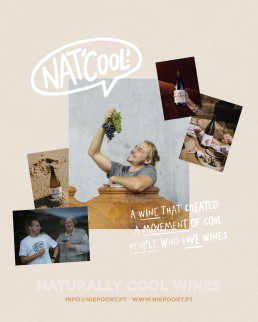
Staff 'Organic Picks'
“Consumption is changing and moving towards organic wine”
Dr Jamie Goode, Wine Anorak
In these times of drastic meteorological chaos and change, we all seek to be a little bit “greener”. We buy organic produce, shop with reusable bags, and recycle more than we used to. With sustainability and natural movements front and centre in our minds, the conscientious practices of organic wine-growing seem to feel ‘right’ for many of us. Perhaps now, more than ever, it could be timely to seek out some exquisite organic wines and taste test for yourselves!
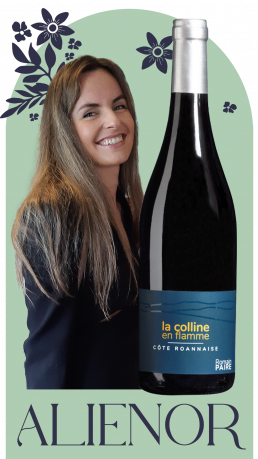
Alienor Moreau, Auckland Account Manager:
Domaine des Pothiers La Colline en Flamme Rouge
““If you are a Gamay lover, let me take you to a very rare appellation of the Loire Valley: the cote Roannaise. The Colline en Flamme is made from a variant of the Gamay called Gamy Saint-Romain. A very accessible, fresh, juicy and gourmand wine to share over dinner with your friends!”
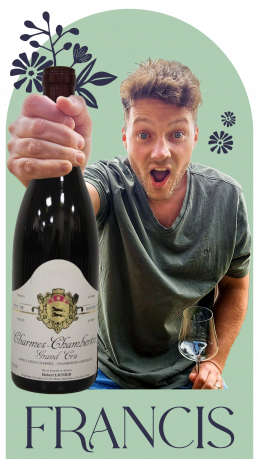
Francis Auclert, Wellington Account Manager:
Domaine Hubert Lignier Charmes Chambertin Grand Cru
“People sometimes forget that OLD WORLD regions and wineries do practice organic / Biodynamic! There is nothing like Burgundy, a region producing legendary wines from a history terroir with savoir-faire that makes tasty masterpieces!”
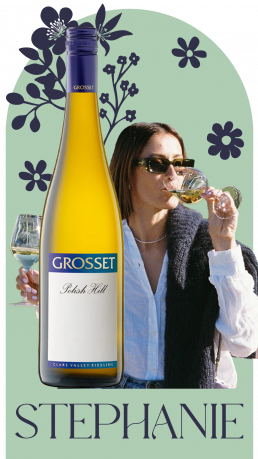
Stephanie Brooke, Central North Account Manager:
Grosset Polish Hill Riesling
“A bloody good drop! Lemon, peach, mineral (with a little hint of patriotism for over the ditch 🐨) It’s just so yum.”
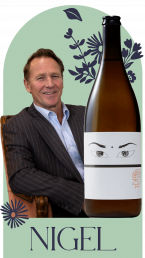
Nigel Kelly, Auckland Account Manager:
Nat’Cool Branco
“The Nat’Cool Branco was one of the first wines put in front of me when I started at Dhall & Nash and thus it’s a bit of a reference point. It’s easy, tasty and comes in a 1 litre bottle so it’s 33.3% more wine to enjoy than your standard bottle. Perfect for this upcoming summer.”
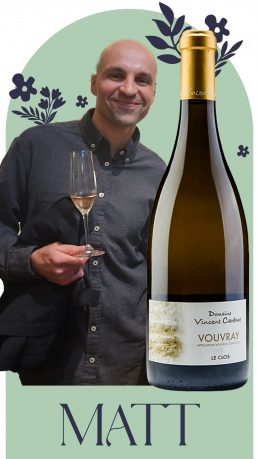
Matt King, Christchurch Account Manager:
Vincent Carême Le Clos
“So modestly priced for a wine of this energy, complexity and drive. Class in a glass! (60+ year old Chenin Blanc vines lovingly tended to in a walled single vineyard in Vouvray).”
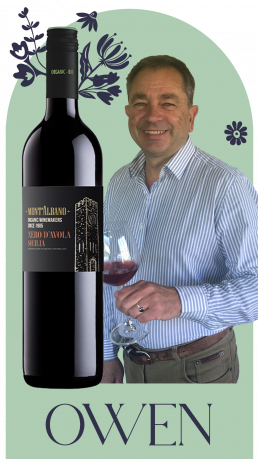
Owen Wood, Queenstown Account Manager:
Mont’Albano Nero d’Avola
“Mont’Albano was green before it was in fashion. From Sicily, this wine sings of its extreme terroir. Rich and ripe dark fruits, dried herb and toasted nut aromas. Succulent palate and silky tannins… a truly complex expression of the Mediterranean. Nero d’Avola pairs perfectly with roasted and grilled meats, ideal for those BBQ days on the way.”
Ultimate Staff Pick:
After our account managers put forward their personal picks, we sent out a company wide poll so we could ALL anonymously vote for the DN Ultimate Organic wine for 2024. Our final winner? Well…
Alienor’s Pick – Domaine des Pothiers La Colline en Flamme Rouge!
Here’s Dhall & Nash’s Organic and Biodynamic wineries: Folium, Cristom, Flowers, Duckhorn, Flowers, Hyde de Villaine, Spottswoode, Larmandier-Bernier, André Clouet, Domaine Muré, Alphonse Mellot, Domaine Testut, Vincent Careme, Domaine des Pothiers, Domaine de Noiré, Morey-Coffinet, Hubert et Laurent Lignier, Louis Jadot, Paul Jaboulet Aîné, Causse Marines, Château Gassier, Maior de Mendoza, Pares Balta, Niepoort, Drink Me Nat Cool, Mont’Albano, Sartori di Verona, La Stoppa, San Felice, Le Macchiole, Col d’Orcia, Château Marsyas, Château Bargylus, De Martino, Santa Ana, Grosset
Frank Cornelissen 2020 - New Vintage, New Hotness
Frank Cornelissen 2020: New Vintage, New Hotness
Another Hot Drop from the Godfather of Natural Wines

It’s 2024 and not only have we secured the newest vintages from the volcanic slopes of Sicily’s Mount Etna, but there’s a new hotness among them from the Godfather of Natural Wines: Frank Cornelissen’s Susucaro Rosso 2022! Produced with the same thought process and vinification techniques that’s made Frank’s other wines an organic icon of the winemaking industry, we’re very excited to introduce this new icon to the New Zealand market.
“Cornelissen is pushing toward the top of his dramatic arc, as I discovered during a recent visit with him. His wines have never been better”
– Monica Larner for Robert Parker’s The Wine Advocate, 2023
For anyone that’s watched The White Lotus Season 2, you’ll know how beautiful active stratovolcano Mt Etna is, and how it dominates the landscape with its ever-steaming activity. On its slopes, beneath the glow of molten rock is where you’ll find Azienda Agricola Frank Cornelissen, led by – you guessed it – Frank Cornelissen. Here, they grow grapes, olives and forage for juniper berries for winter stews (it’s like a lava-tinged Disney scene).
About Frank Cornelissen
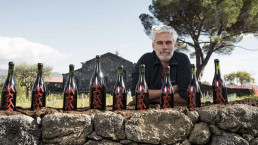
“One of the most significant figures in the revival of winegrowing on the slopes of Mount Etna”
– Robin Lee for The World of Fine Wine
Robin Lee sums Frank up nicely, and we’ve blogged extensively about this humble icon before, which you can read here:
- Oct 2023: New Year, New Frank
- May 2023: Red Hot ‘n’ Smokin’
- May 2020: Too HOT to Handle
But for those not wanting to go down a click rabbit-hole, let’s summarise…
When the Belgian ex-fine wine dealer came to Etna in 2001, his vision was that this is one of the few locations on Earth where wine could be made without any manipulation. He purchased old vines that had been planted during the Phylloxera crisis (which couldn’t survive in the volcanic soils here).
Mistakes were made as he learned along the way, but with time, the style of Frank Cornelissen became renowned. His hands-off approach was deemed extreme, even by his own standards and he admits that perhaps he took it a little too far sometimes. “My wines used to be anti-wines,” admits Cornelissen. His initial philosophy was never to use sulphur dioxide (SO²) in his wines. In every wine making decision, his aim was for absolute purity. His uncompromising and often extreme, (but always creative) visionary efforts to maintain the highest level of cellar hygiene without using SO² made him an idol of the natural wine world. However, over the past 22 years, trailblazing Cornelissen has needed to evolve. He has modified his thinking and methodology of this earlier philosophy.
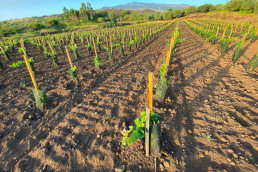
Still today, this is a winery that practises non-interventionist principles across their twenty-four hectares and eschews overhandling of the wines in the winery and cellar. However, there have been a number of changes to the process, including the fact he’s now using minimal amounts of SO² during racking and before bottling. “Quality- focused with natural being the inspiration, not the destination” explains Jancis Robinson MW.
“Frank Cornelissen is an Etna pioneer, and his contributions to the success of this special Sicilian wine region are immeasurable. His influences on Italy’s natural wine movement are equally important, and he was alone in embracing both concepts (Etna and natural wine) simultaneously. His winemaking experiments on the volcano started in 2001, and Cornelissen emerges as a major figure today”
– Monica Larner for Robert Parker’s The Wine Advocate, 2023
In a profile by Jancis Robinson, Cornelissen confessed that “2015 was my learning vintage that showed me the limit [of non intervention]. 2018 showed that I should have added a little SO² to 2015. 2017 was OK but 2018 really needed the SO². It was 2018 that changed my mind about SO². I’m very happy with the new technique, and 2020 is where I really want to get to. 2019 was deceptive. The fruit was very, very clean but we still needed the sorting table because there was a lot of variation. 2018 though was really difficult.”
“[Cornelissen] calls his 2019s ‘pretty’ and likens his 2019 Nerello Mascaleses to Pinot Noir whereas 2017 was more like Nebbiolo. His favourite vintages are 2011 and 2020.”
– Jancis Robinson “Soldera and Cornelissen” 2022
The 2020 Vintage
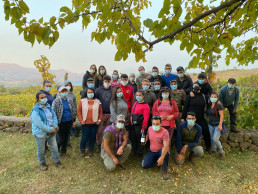
“What can I say, Frank Cornelissen is at the top of his game, [] and I can honestly say that I have never seen such precision, purity, and consistency as I’ve seen tasting the last few vintages”
– Eric Guido for Vinous
Our newest shipment of Frank Cornelissen wines includes a wave of goodies from the 2020 vintage, as well as a new gem – Susucaru® Rosso – from 2022.
Every year, Frank releases a vintage report. For the 2020 wines, he’s dubbed the vintage officially ‘Great’:
“The real winter came only at the end of January but with good snow; the pruning was finished late as we had to do some corrective pruning in a new vineyard which took more time than planned.
“The rest of the season was relatively balanced and we slid into the harvest pretty smoothly, albeit with some stress for some workers concerned about getting COVID and sending the whole team in quarantine… It was very stressful to keep everybody safe and sound but we managed with lots of precautions.
“Harvest went pretty easy as the nice weather was continuing until late autumn. A nice compensation for the COVID stress!
“The reds have a nice balance and I like the structure of the wines as tannins are present and it all fits nicely.
“Magma was picked in perfect zodiac and I was really happy. The Bianco Vigne Alte will be promising.
“My preferred wine of this vintage: Susucaru® Rosato for its rich flavours and freshness combined.”
Susucaru® Rosso The New Kid on the Block
The Susucaru® wines are the entry-level range from Frank, and after the roaring success of the Rosato (which we almost have to hide from our DN staff) we’re super excited to add the Rosso to the lineup.
2022 Frank Cornelissen Susucaru Rosso
The 2022 Susucaru Rosso is a field-blend of mostly Nerello Mascalese (85%) with other local varietals all the vineyards: Nerello Cappuccio, Allicante Boushet, Minnella and Uva Francesa. Susucaru® Rosso perfectly expresses Etna, as it is produced in a more traditional way, blending different contrada’s as well as different varietals to obtain a fragrant, elegant and fluid wine with structure and personality.
The name Susucaru® comes from a Sicilian expression meaning “they stole it”, which is what Frank’s crew shouted when they realised most of the grapes from their first vintage had vanished.
From Vineyards Picciolo, Malpasso, Campo Re, Crasà, Piano Daini, Feudo di Mezzo. Grapes were destemmed and lightly crushed, before fermentation with a “pied-de-cuve” using only indigenous yeasts and skin contact for about 30 days. It was aged in neutral epoxy tanks from 2500-7000 litres. No fining, and filtering occurred before bottling with cartridges of 3 micron.
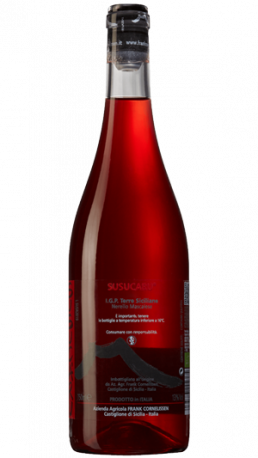
The Explosive New 2020 Batch from Frank Cornelissen
2020 Frank Cornelissen MunJebel Rosso 'VA' (Vigne Alte)
A blend of ungrafted Nerello Mascalese from Cornelissen’s three highest vineyards (hence Vigne Alte or ‘Tall/High Vineyards’): Tartaraci (1000m. asl), Barbabecchi (910m. asl), Rampante soprana (870m. asl)
“The most Burgundian of all our crus.” Nerello Mascalese 100% from 90+ year old ungrafted vines. With an annual production of only 2,500 bottles. Grapes were destemmed and lightly crushed before a “pied-de-cuve” fermentation using only indigenous yeasts and skin contact for about 60 days. Aged in neutral epoxy tanks from 1500-2500 litres for 18 months and another 18 months in bottle. No fining. Filtering before bottling with PP cartridges of 5 micron.
Previous Vintages Accolades:
- 16.5+ Points Jancis Robinson (2019)
- 97 Points Robin Lee World of Fine Wine (2019)
- 96 Points Decanter (2017)
- 93 Points Robert Parker (2017)
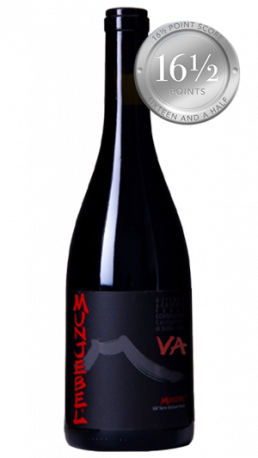
2020 Frank Cornelissen MunJebel Rosso ‘MC’ (Monte Colla)
This pure Nerello Mascalese comes from contrada Monte Colla. An extremely steep and terraced vineyard, beautifully exposed to sun and wind and right in front of Mount Etna. The sandy clay soil and the old-vine Nerello Mascalese, planted in 1946, produces a rich and powerful wine, maintaining grace and elegance. Our “Hermitage” of Etna.”
“Monte Colla MC delivers punchy red fruit flavors with rose, lilac and hints of powdered licorice root. There is a subtle play of fruit versus floral intensity in this wine. The vineyards enjoy heavier soils, with clay in part, that are rich in silicon at 780 meters in elevation. The vines were planted in 1948 and 1949 with south-southwest exposures, where they get the last light of the day. These are ancient soils, and marine fossils are sometimes found on Monte Colle. Geologically speaking, this site is unique in the Etna context.”
94 Points, Robert Parker’s The Wine Advocate
“Lovely cool berry, orange blossom, pumice, smoke and lava aromas, but subtle and complex. Bark and mushroom, too. Full-bodied and very structured with powerful tannins that are polished and thought-provoking. This needs time to soften. Clearly one for the cellar. Best after 2026.”
96 Points – JamesSuckling.com (8/4/23)
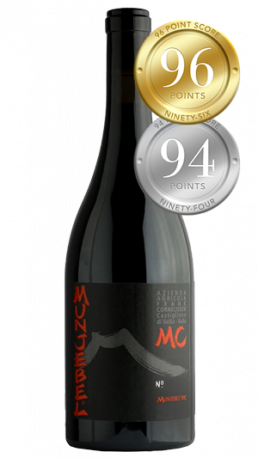
2020 Frank Cornelissen MunJebel Rosso ‘CR’ (Contrada Campo Re)
This pure Nerello Mascalese comes from a partly ungrafted vineyard ‘Campo Re’, situated at the far western side in the valley floor, at the entrance of Randazzo. The vineyard altitude is 735m. asl and is characterised by deep soil which, in humid vintages creates major difficulties to obtain ripe fruit. The wines are profound and tannic, and more Nebbiolo-ish compared to other crus.
“I like the aromas of vine bark, rose stem, light parsley, and red fruits that follow through to a medium body, with white pepper and cloves with a fresh and vivid finish. Tight and tannic. Shows tightness and focus. Best after 2025 but already fascinating to taste. (8/4/23)”
95 Points – JamesSuckling.com
“These results from 2020 show a lot of fruit character and dark cherry concentration with hints of curry leaf, mint, oregano and some of the wild herbs that grow on the volcano. The tannins are softly integrated and the acidity is bright. Mineral nuances add complexity.”
92 Points – Robert Parker’s The Wine Advocate
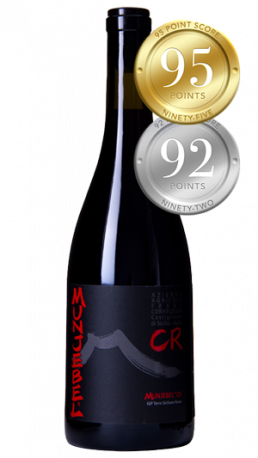
2020 Frank Cornelissen Magma
Magma® is Frank Cornelissen’s top cuvée, their “Grand Vin” and is produced only in great vintages where they achieve phenolic ripeness. Hailing from the Barbabecchi vineyard at 910m. asl. Planted around 1910 and North-North East exposed, capturing the first and cool morning sun rays. A profound wine, rich as well as elegant, with character, personality and great finesse. Vinification starts with a “pied-de-cuve” using only indigenous yeasts and skin contact for about 50 days before aging in neutral epoxy tanks 1500-2500 liters for 18 months and another 18 months in bottle. Annual production in the years it’s produced is around 2,000 bottles.
Bottles are hand-painted and to combat the increasing risk of counterfeit bottles, since 2016, Magma® has an NFC chip integrated into the label of each bottle which contains information regarding the authenticity of the wine.
In addition to the microchip, Magma® uses unique Ardeaseal closures on the bottles and magnums, further guaranteeing authenticity as these patented closures are manufactured in only one factory in the world.
“The Frank Cornelissen 2020 Sicilia Nerello Mascalese Vigna Barbabecchi Magma is a creative and original wine that is a lot of fun to drink and dissect. Fruit comes from a vineyard site at about 1,000 meters in elevation above the Contrada Rampante. This 2.5-hectare site was planted in 1910, and more than half of the fruit goes toward this production. The wine offers ample richness and volume with dark berry, campfire ash, grilled herb and cola.”
94 Points – Robert Parker’s Wine Advocate
Previous Vintages Accolades:
- 18 Points Jancis Robinson (2019)
- 96 Points Robin Lee World of Fine Wine (2019)
- 97+ Points Decanter (2019)
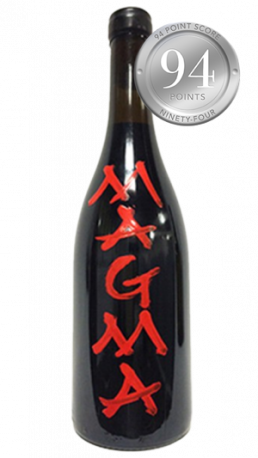
Also Still Available...
2022 Frank Cornelissen Susucaru Rosato
(Prior vintages sold out!)
Frank’s famous Malvasia, Moscadella, Insolia, and Nerello Mascalese Rosato blend – made with skin contact for texture and territorial identity, malolactic fermentation fully finished for density, fluidity and stability. A bright salmon pink. Intense perfumes of young fruits introduce sapidity and minerality. Drinking Window: 2023 – 2030
“I was privileged to taste the wine – Susucaru… bottom line is I taste this natural stuff and my eyes just lit up, some lightbulb went off and I feel like this is where the journey of life has taken me, and where I need to continue to explore.”
Action Bronson for Vice’s Munchies Series
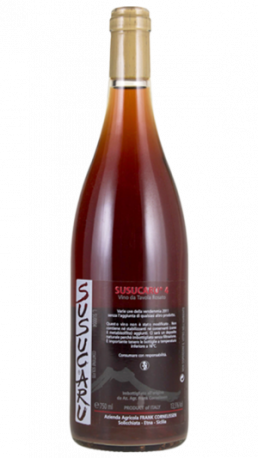
2021 and 2019 Frank Cornelissen MunJebel Rosso
The Classic MunJebel Rosso is Frank’s vision of a traditional, balanced and rich Northern Valley Etna wine. A rich and fragrant wine of pure Nerello Mascalese from different vineyards, partly from their best parcels where we produce our crus (Zottorinoto-Chiusa Spagnolo, Feudo di Mezzo-sottana and Porcaria) as well as designated vineyards for this specific wine (Rampante Sottana, Piano Daini and Crasà).
2021: “Expressive and decidedly gentle and harmonious in the main profile, it shows notes of black plums, marjoram, lavender, hibiscus, black olives, strawberries, geraniums and white pepper. Medium body, creamy tannins of splendid elegant shape, perfectly polymerized and a finish of commendable beauty.”
94 Points WinesCritic.com
2021: “Seduces with a rich and sweetly scented bouquet of crushed black cherries, dried roses, and cloves. It’s silky in texture, enveloping all that it touches with ripe red fruits and spices, nicely framed by saturating minerality, as inner violet florals form toward the close. There are tannins here, but they don’t get in the way; instead, they create a perfectly dry platform where notes of lavender, plum and allspice hover above.”
92 Points Vinous
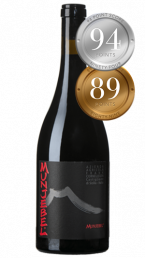
2020 Frank Cornelissen MunJebel Bianco
Cornelissen’s first white wine started out as an orange wine, fermented with the skins for an extended period. Frank liked the tactile feeling and density, but missed the finesse and precision of the classic French white wines, so he changed the technique to search for the purity and flavours of Etna. This transpired as a short period of skin contact and ageing for an extended period in the coldest part of the cellar before bottling. The obtained elegance, purity and density makes this wine very suited to accompany a wide variety of dishes and cuisine, from fish to white meat. 50% Grecanico and 50% Carricante.
“It is beautifully pure for a natural wine, and while rich, almost oily, there is drive and persistence to the gingery, herbal and stonefruit flavours.”
Different Drop
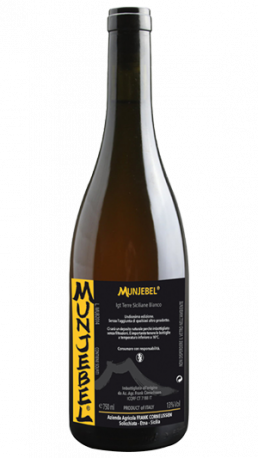
Parés Baltà: Scintillating Spanish New Wave Wines
Mas Vino Por Favor!
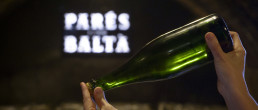
Is there no end to the energy and brilliance of Parés Baltà’s wines and the creativity of its female winemakers. Absolutely not! There seems to be an unspoken obsession with pure expressions of terroir that really sets this estate apart. Each and every one of the Parés Baltà wines is distinctive, expressive, and stunningly scrumptious; not to mention, that their entry level Cava is multi-award winning and about the best value Methode Traditionnelle on offer.
Obviously, we couldn’t hold out any longer! Dhall & Nash has nabbed another trio of their new wave still wines which are unfailingly brilliant.
Tasting these new wines demonstrated to us how the Parés Baltà team manage to combine all the right elements to achieve a balance of energy, complexity and drinkability that is nothing short of wine nirvana. Taste & see!
At Parés Baltà the focus is on seamlessly marrying the incredible purity of fruit with the primacy of their unique terroir. At the risk of sounding like a hard sell, you should go deep on this offer to give your palate a welcome blast— these are amongst the most transparently luscious and great value wines out of Spain. No question!
Parés Baltà
Delivering terroir-true excellence
The Distinctive Wine Region – of Penedès D.O. is tucked away between coastal hills, south-west of Barcelona in Catalonia, and to the north-east of the other historic winemaking region of Tarragona. Penedès’s fame historically rests chiefly on its Cava sparkling wine (which was granted its own Denominación de Origen in 1991). Cava sparkling wines must be made according to the “Traditional Method” (secondary fermentation in the bottle like champagne) and are required by law to have a minimum of nine months’ bottle ageing following the fermentation. Over 90 percent of Spanish Cava comes from the Penedès region. Generally, white grape varieties dominate here, but the region also offers a host of well-made red wines as you’ll discover from the forward-focused Parés Baltà Estate.
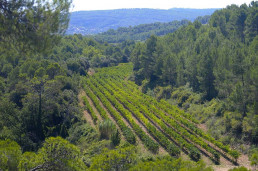
The Parés Baltà Story
Great Wine. It takes Generations.
The winery, located in the town of Pacs del Penedès (close to Barcelona), has a long winemaking history, having been founded in 1790 when the first vines were planted on the estate that now surrounds the winery. Today however, more than 230 years later, a lot has changed.
In 1978, Mr Joan Cusiné Hill took over the winery. Born in 1917 in Bellvei del Penedes, Mr Joan Cusiné Hill came from a family of grape growers and, already from the age of seven, he helped his father to cultivate the vineyards and never stopped working. Even into his 90s he was helping his grandsons care for parts of the vineyard.
His son Joan Cusiné Cusiné started to manage Pares Balta in the 1980’s and released its first still white wine, “Blanc de Pacs” which is still produced today. At the end of the 80’s the first red wine from the company was produced.
Then it was time for the next generation to bring more innovation. Since 2000 the winery has been managed by Joan and Josep Cusiné Carol, grandsons of the company founder. However, it was the changes brought about by the women they married, winemakers Maria Elena Jiménez and Marta Casas, that has shot them into the vinous stratosphere.
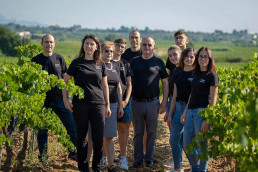
Josep’s wife, Marta Casas, and Joan’s wife, Maria Elena Jimenez, both came to winemaking by way of science; Marta had trained as a pharmacist before switching to oenology, and Maria Elena had been a chemical engineer. These two extraordinary women started work at the winery – in 1999 and 2002 respectively – having retrained as oenologists at Tarragona university.
When Marta and Maria Elena arrived at the winery, the family was just doing a few still wines but more focused on volume than quality. They started gradually changing methods of viticulture, winemaking, and blending styles. They made a quiet revolution take hold at Parés Baltà winery. Even though they have brought new and fresh ideas into the company, they have also shown respect for its traditions and protected the estate’s heritage.
Ultimately, encouraged by the Cusiné family and together with her sister-in-law, Maria Elena, Marta spearheaded a revolution in winemaking practices, prioritizing wines that honoured the unique terroir, aiming for maximum character and identity.
Today, Pares Balta produces a wide range of high quality wines and cavas that has been both nationally and internationally acclaimed. Always keeping quality in view, their aim is to produce some of the best and most representative wines in the world.
“It takes more than great grapes to make a great wine.”
– Joan Cusiné Carol, Winery Co-Proprietor
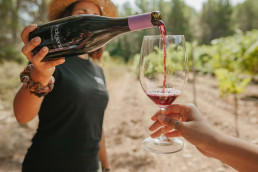
Parés Baltà believes that great wines can also convey great emotions. Because of this, the winery strives for an organic, minimal intervention process in order for the grapes to truly present the culture and traditions of the region. In this way, each of their wines is a fascinating, yet importantly, a delicious study in terroir.
Our passion for nature has always been the primary driving force to grow our vines organically, certified since 2002, and biodynamic since 2012.
– Parés Baltà Website
The New Wave Wines
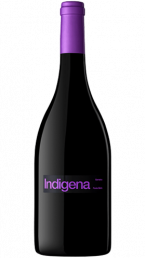
Parés Baltà Indigena 2021
“Very approachable. Again 100% Garnacha, [ ] fermented on the skins for a number of weeks [ ]. Floral hints of potpourri on the nose. Dark chocolate, cassis, baking spices, black berry fruits. Medium tannins and a long, dry finish.”
Phil Parker, Wine Reviewer, Ponsonby News
At the Parés Baltà Les Torres estate, at the top of the Penedès, they have individuated a unique vineyard site that produces the freshest and sweetest Grenache, a worthy hero for this single varietal wine. Following their estate commitment, this 100% grenache is grown organically and biodynamically. Its resistance to extreme temperatures and its easy adaptation to poor soils make it a perfect variety for making quality wines in the Mediterranean climate. Versatility is another of Garnacha’s strengths, which is why Parés Baltà are fans of it.
On the nose, there’s a range of wild red fruit accompanied by subtle toasted touches due to its brief stay in wood.The importance of the fruit is also evident on the palate, leaving a good trace of its elegance and smoothness. Its personality invites you to taste it and to repeat.
Winemaking – The grapes are harvested by hand and after receiving the grapes in the winery, they are gently pressed and fermented at 20ºC in stainless steel tanks for 2 weeks with 3 daily remuage. Indigena Red is aged in new and second year French oak barrels for little time so as not to add too much wood and to maintain its characteristic fruity touch.
“Intensely fruity, fine-grained, and very balanced. It will age well but is already perfect for drinking now.” 17/20
Julia Harding, Master of Wine, Jancis Robinson.com
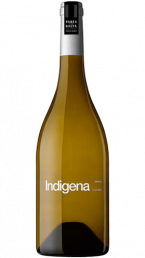
Parés Baltà Indigena Blanc 2022
“Indigena Blanc 100% Garnacha blanca “grown organically and bio-dynamically in vineyards in the Penedès. Bone dry, lean, and crisp, with tannic grip and spice from ageing in a mixture of new and old French barrels. Gooseberry, green bell pepper and herbal thyme.”
Phil Parker, Wine reviewer, Ponsonby News
A 100% White Grenache grown organically and biodynamically, in the highest areas of the Penedès, at an altitude of over 600 metres above sea level. A single varietal that manages to extract all the expression of the freshness thanks to the altitude where it grows. The winery’s oenologists, Maria Elena, and Marta, carry out a minimum of intervention in the cellar to keep its full potential and natural qualities intact.
In this vintage of Indigena Blanc, flowers and white fruit are complemented with citrus and creamy notes due to the months long lees contact. A wine with a delicate balance between freshness and vivacity. On the palate there is volume, balance, and it has a long lingering finish.
Winemaking – They harvest the grapes by hand and after receiving the grapes in the winery, they undergo a maceration of 4 hours, the grapes are gently pressed and fermented in a stainless steel vat for 20 days at an average temperature of 16°C. After fermentation, the wine remains in contact with the fine lees from the previous fermentation for approximately 3 months with daily bâtonnage. The wine is aged in new and second year old French oak barrels.
“Very ample and citrusy drink, with very rich acidity.”
El Diario, Elisabeth G. Iborra, Wine journalist
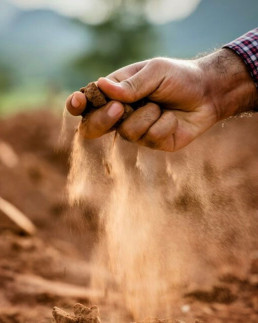
Amongst The Vines & In the Soil
Alongside an emphasis on tradition and quality, the environmentally respectful cultivation of the vines is key to Parés Baltà’s sense of identity.
The vineyards of Parés Baltà span five premium estates, covering 176 hectares of carefully cultivated, low-yielding vines. They are spread out across a wide variety of soils and each experiences a slightly different climate. As the microclimates and soils favour each grape variety differently, it is a complex and challenging task the Parés Baltà team faces to find the environment that gives the vines the best conditions to develop their unique personalities and vinous traits.
This current generation of vintners is turning to old ancestral grape varieties, better adapted to their land and environmental pressures. “We are working with varieties to fight against climate change,” says winemaker Marta, “we realise we have jewels with our ancestral varieties.”
In the hills of Penedés, Parés Baltà’s vineyards sit at altitudes ranging from 170 to almost 800 metres and they are only 10 kilometres from the sea. In the highest vineyards, thermal air currents and considerable diurnal temperature fluctuations allow the grapes to ripen slower and they are often harvested 4-6 weeks later than grapes grown in vineyards at lower altitudes. Vineyards planted on terraces along the Foix river have an entirely different set of conditions, with their own set of challenges and their own distinctive styles of wine.
There is also a significant diversity of soils, including calcareous, clay, and areas with important quantities of marine fossils. The soils of Parés Baltà’s best vineyards are generally poor in quality and have very little organic material but with biodynamic viticulture this has improved. The area with marine fossils is closer to the Mediterranean Sea, and millions of years ago it was under water. This type of soil is characterised by its permeability, and it retains little water. That makes the vines work hard to find water by sending roots deep into the earth, producing small quantities of grapes that are high on flavour, complexity, and concentration.
Over the last 20 years, the Pares Balta estates have benefited from a rich biodiversity thanks to the different cultivation and fertilization methods that they practice. To achieve the maximum vitality of their vines they use Biodynamic Preparations, they work with cover crops, promoting biodiversity, and they integrate animals into the work in the fields, such as a flock of sheep and goats. They also use bees to help vine pollination and create a more sustainable world.
– Parés Baltà Website
Biodynamic Commitment: the Parés Baltà Philosophy
All of their wines are certified as organic, and all of their vineyards are Demeter certified as Biodynamic. As part of their commitment to improvement, in 2011, the first biodynamic compounds were used on some experimental plots. One year later, the excellent results encouraged them to extend the practice to their entire vineyard holding. Biodynamic farming seeks to provide maximum vitality, self-balance, and harmony to the vineyard. They utilise biodynamic preparations and homeopathic remedies to help convey the influences of the cosmos to the vineyard. Whether you believe in such things or not, it has been shown to result in higher fertility, hardier vines, natural pest control and it is an internationally proven form of agriculture based on biodiversity and astronomy.
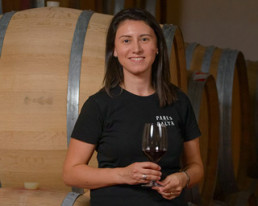
Marta Casas, of Parés Baltà was awarded the prestigious title of this year’s ‘Winemaker of the Year’ by the renowned British wine writer Tim Atkin MW, in his recently released report on Catalan wines ‘Special Report Catalonia 2024’.
The wines at Parés Baltà and Gratavinum are made with minimal intervention. “We are working with very low SO2 levels. We are also doing some wines without any sulphites at all,” says Joan Cusiné Carol. “We believe that drinking wine should be a nice, pleasant experience, and also a healthy one.”
Parés Baltà’s winemaking prowess shines through in its use of a diverse range of grape varietals. As well as making Cava, “we put big energy into our still wines. We like to be innovative and to investigate the research, but at the same time, learn from our ancestors.” For example, the winery vinifies in stainless steel, some barrels and demijohns, but, since 2011, also in clay amphorae.
This isn’t some modern fad they’ve adopted. Cusiné Carol says that in the upper part of one of the vineyards, kilns dating back more than 2,000 years had been found. They were for making amphorae which in Roman times would’ve been used to store and ship wine, oil, and honey.
Working with the clay vessels has opened up new winemaking possibilities. “We realised that, depending on the amphora type and how the clay was cooked, the wines tasted different.” What a happy coincidence to then utilise this newly discovered legacy to reveal another element of their terroir.
“Wines made sustainably are true ambassadors of their terroir”.
Jordi Fernandez, Co-Owner & Winemaker of Gratavinum
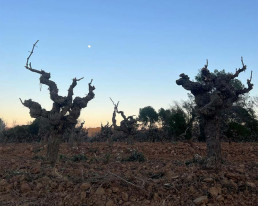
The Gratavinum terroir of organically-farmed terraced vineyards, are rich in Llicorella. This is the Catalan name for a special type of soil in Priorat, which consists mainly of reddish-black slate with small particles of mica quartz, with the different layers of soil being filled in by clayey soil. It is a rock formed over 1000’s of years of compacted sediments providing a distinctive mineral character to the wines of the Priorat region. Undoubtedly the nature of the Llicorella is part of the magic of these wines.
Jordi Fernandez unsurprisingly is enamoured by the singularity of this land, saying “You can taste the unique footprint of Priorat in the wines. Beyond the fruit, there’s minerality – smoke, graphite, wet leaves, and forest floor – the kind of earthy smell you get when it rains in Priorat. Each time I taste my wine, I can taste the terroir.”
“After several years of organic viticulture in both Penedès and Priorat, we had understood the link between the environment and the vines. We did the course in biodynamics with a ‘let’s see’ attitude, but it changed our lives – here was a whole new world.”
Marta Casas, Winemaker
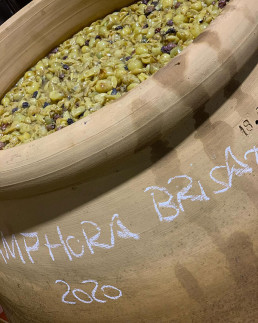
The Other Passion Project – Gratavinum
Whilst studying oenology at Rovira Virgili University in Tarragona, a young Jordi Fernandez became firm friends with fellow students Marta Casas and Maria Elena Jimenez and later, their husbands, brothers Josep and Joan Cusiné of the Parés Baltà winery.
The group of friends bonded over environmental concerns, and wine travel and on an impulse, decided to make wine together in the highly regarded wine region of Priorat. They managed to find adjacent plots of land beyond the village of Gratallops, and today are proud owners of 17 hectares, including some old, terraced vineyards (costers) and the winery which they built from scratch.
Thus, in 2003 Gratavinum the passion project was born. The name comes from the contraction of Gratallops (the village where the winery is located) and Vinum, which means wine in Latin, in homage to the Romans, who introduced the cultivation of vines in the region many centuries ago.
Jordi Fernandez now heads Gratavinum. Meanwhile the other friends-business partners focus on Parés Baltà in the Penedès. Then all five come together to decide on the final blends for Gratavinum which now makes 20,000 bottles of biodynamic wine annually, split over 5 labels.
Coincidentally, the group’s curiosity about biodynamics lingered long after they finished studying oenology, and in 2010 they found themselves attending a workshop by biodynamic certification agency Demeter. The group began preparing to go biodynamic – the Cusines at their winery, Fernandez in Gratavinum. Certified organic in 2003, Gratavinum got its biodynamic certification from Demeter in 2014.
“We are giving life back to the soil – enhancing life in every form, above and below the ground,’ he says, ‘Does that make the wine taste better? I think so”
Jordi Fernandez
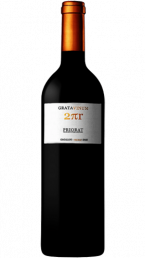
Parés Baltà Gratavinum 2ΠR 2021
A blend of 65% Grenache, 25% Carignan, 10% Syrah + Cabernet Sauvignon cultivated applying biodynamic farming in their vineyards in the Priorat.
In the crafting of this wine, the team at Pares Balta with partner Jordi Fernandez, have brought the unique character of Priorat terroir together with the softness, balance, and fruitiness of their grapes.
Tasting Note – Aromatic intensity and complexity with explicit presence of preserved red fruit well balanced with the touch of toasty notes from the oak.
On the palate the entry is soft, but it changes showing unpolished ripe tannins together with good volume and acidity. Fruity notes with a mineral character at the end of the mouth. Long and fresh aftertaste.
Winemaking – Pre-cold maceration of 7 days. Alcoholic fermentation for 16 days at a controlled temperature of 25ºC in stainless steel tanks. Ageing 60% for 12 months in new, second and third year French and Hungarian oak barrels of 400l, 20% ageing in clay amphoras for 10 months and 20% in 54l demijohns for 12 months.
“What’s spellbinding about this wine is the acidity and the freshness. Yes, it’s Priorat and it’s a big wine, but so nimble and full of tension. Packed with redcurrant and raspberry, hints of cacao and woodsmoke. Impressively fruit focused.”
The Morning Claret, Simon J. Woolf, Wine journalist
Without a doubt, Parés Baltà Winery embodies a harmonious blend of tradition, innovation, and a deep respect for the land. With each sip, their wines transport you on a journey through time and terroir, showcasing the passion and dedication of a winery deeply rooted in its heritage while embracing the possibilities of the future.
Other Parés Baltà wines stocked by Dhall & Nash:
- Materia Prima Orange 2022 [shop online]
- Materia Prima Pet Nat NV [shop online]
- Parés Baltà Cava NV [shop online]
From Where We'd Rather Be: 2023 Vintage Harvests Are Wrapping Up In The North!
The 2023 Harvest Wrap Up
As picking wraps up in the Northern Hemisphere, we're watching closely in anticipation!
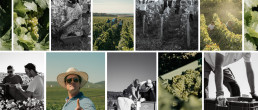
Champagne Billecart-Salmon
Mareuil-sur-Aÿ - Champagne - France
-
- 8 September: It’s the vine’s time to shine. Harvest season is off to a promising start. We cannot wait to discover what gifts this vintage will reveal… From vine to hand, we take nature’s achievements and sublimate them into triumphs of savoir-faire.
-
- 14 September: Kissed by the summer sun, our Chardonnay grapes are ready to be transformed into liquid gold, just as they have for over 205 harvest seasons.
-
- 20 September: The pursuit of the perfect shade of pink is a true labor of love. Once the vines have gifted us with their precious fruit, our dedicated winemakers meticulously sort the red grapes that will give the radiant, blushing hue to our rosé cuvées.
-
- 21 September: A first look, and unforgettable impression. The voyage from vine to glass begins with the extraction and settling, or ‘débourbage’, of precious juice before the cold and slow fermentation process begins under the watchful eye of Florent Nys, chief winemaker.
- 23 September: The journey begins—a voyage from vine, to crate, to oak cask—guided every step of the way by the gentle hands of our vine workers and winemaker.
We cannot wait to discover this year’s flavourful destination.
Champagne André Clouet
Bouzy - Champagne - France
An abundant and beautiful grape harvest is coming to an end, making 2023 one of the hottest harvests of the century.Mother Earth has given us the gift of abundance. Exceptionally large bunches of grapes, magnificent Chardonnays, despite a slightly more difficult harvest for the Pinots. 2023 could be a surprising vintage…
Pares Balta
Penedes - Spain
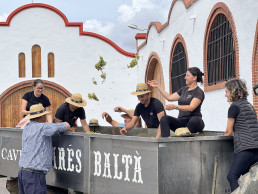
We want to give a little summary of the harvest in 2023, which has been the shortest ever made at Pares Balta. We started August 09 and ended September 19.
Never in my life – in the 21 vintages I’ve made – have I seen this at home.
And what has been very peculiar has been how the drought has affected the plants under water stress, obviously with high temperatures as well. We have only had one heatwave in August ’23 – 5 days of peak heat and the noral order of ripening has been altered.
The reds came at the same time as the whites. White ones are harvested usually at the beginning, then more came and in the end there has been chaos-but we have successfully done it. We have solved technical and organisational decisions very quickly. and successfully.
We are very happy and we have to say that the greatest peculiarity is that this phenolic maturity in the skins of the red varietals has been an incredible case in which we had good skin maturity but instead, moderate graduation – not a very high graduation. ie. Correct sugars and balanced acidity – which never happens – has gone very well for light red wines.
San Felice
Tuscany - Italy
The most fascinating part of the year is finally with us! The harvest is in full swing and as you walk through the vines on our three properties you will be able to meet our oenologist and his team busy picking and selecting the best bunches. Looking back, 2023 has been a year with extremely varied weather. We started with a warm and dry winter, followed by a spring with an exceptional amount of rain, and then a summer with Saharan temperatures.
The expectations for this year are that the output will be lower than in previous years, but in terms of quality, all the factors are there for some excellent wine to be produced.
You really must be prudent at such a crucial time, so we will wait for the completion of the harvest and to get our precious grapes into the cellar to begin the next stages. Every step will be vital in preserving and getting the best out of the result of a whole year of hard work and passion.
2023 marks an important milestone in our winemaker Leonardo Bellaccini’s career, as he celebrates his 40th harvest. 40 years of passion and dedication for his work and for San Felice. Congratulations to Leonardo from the entire team!
September is the time when grapes have reached their optimal level of ripeness. Grapes are the primary source of sugar, acidity, and flavor compounds needed for winemaking. Winemakers carefully monitor the ripening process, known as veraison, to determine the ideal time to harvest when the grapes have the perfect balance of sugar and acidity.
NEW: Pentire Botanical Non-Alcoholic Spirits
New to Aotearoa: Pentire Botanical Non-Alcoholic Spirits
"The most delicious non-alcoholic drink" - Gordon Ramsay
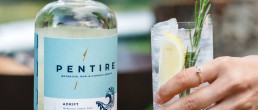
It’s been a long tough winter. Wet, really wet, cold, miserable and everyone’s talking about giving things up – oh no, not Dry July again! We’re all for wellness and a good cause but swapping out our glass of wine for a green tea doesn’t sound like a fair trade…
But wait… When celebrity chef Gordon Ramsay calls something the “most delicious non-alcoholic drink,” you should take note, right? Well, we definitely did that and more! We have brought it into the country: Introducing D&N’s first Non-Alcoholic botanical spirit PENTIRE from the wild coastline of Cornwall, England.
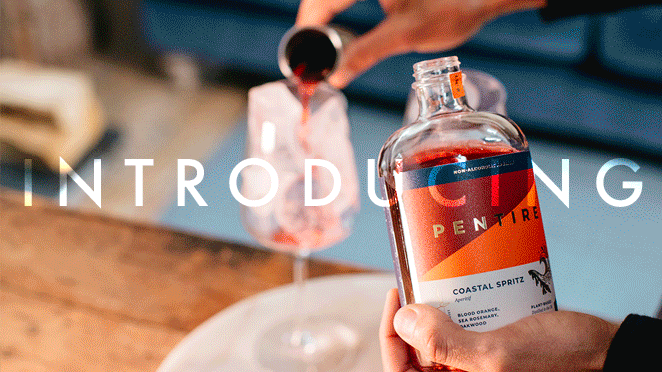
We’ve observed that every year the Non-Alcoholic drinks category gets more exciting, as new entrants to the field bring out interesting innovations and the standard of the offering goes up across the board. And undoubtedly, you know how much we at D&N adore our vino, sherries, fortifieds and fine spirits but at the same time, we’re aware of the broader trends of mindfulness and moderation. Yes, we are thinking more about drinking a little less, yet without settling for an inferior non-alcoholic drink or being less social. Perhaps it was time to be more open to the idea that a drink can be special even if it isn’t alcoholic. And we believe, this quality spirit substitute Pentire, has cleverly found a way to communicate the intensity, complexity, or satiation you’d associate with a rewarding, refreshing and flavourful traditional beverage.
“Catching waves until dusk. Camping on cliff tops and foraging hedgerows for unexpected bounty. Sharing and experimenting with the flavours we found on the coast. We wanted to bottle that experience. And create a drink that harnesses the power, beauty and immense flavours of plants.”
– Alistair Frost, Founder
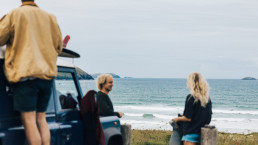
How It Started
Pentire is named after the Pentire peninsula on the rugged Cornwall coast of England. It’s an area known for excellent surf. And Pentire’s founder, Alistair Frost, is a surfer. “Frosty,” as he’s known, was surfing during the day and bartending at night. And he was tired of hangovers interfering with his early-morning wave-hunting. So, he created Pentire along with his friend Ed, a fellow surfer and devoted outdoorsy guy who he met on a charity bike race across Mallorca.
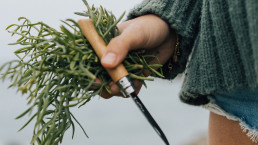
Plant-Powered
Pentire is really a celebration of unique plant life that grows on the surrounding headland of Cornwall. Key botanicals thrive there due to a combination of favourable climate, soil pH, and air moisture. The lads have been particularly mindful that they were crafting a healthier choice for active living outdoor loving people. Now even the rest of us less outdoorsy types can relish the sophisticated flavour profiles of the delectable healthy Pentire range.
“Pentire started with a deep love and appreciation for nature and the outdoors. Creating a non-alcoholic spirit which captures the beauty, power and immense flavour of plants and enables clarity of mind and meaningful experiences outdoors, is what drives us. And it’s these experiences which drive us to do everything we can to preserve, care for and celebrate the environment.”
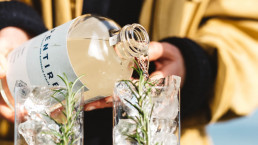
The Liquid
Whatever your reason for foraying into the area of non-alcoholic beverages, you don’t need to be a mixologist to enjoy the impressive calibre and flavours of the Pentire non-alcoholic spirit range
The Pentire Adrift has the highest rating of any non-alcoholic spirit on Trustpilot ratings (an international measurement of customer satisfaction); and there have been some stellar reviews, including from the New York Times in which Pentire was selected in the top 17 Non-alcoholic drinks for 2023.
“This stuff is a natural substitute for gin, but it can also stand alone. As corny as it sounds, when we drank this concoction, we felt as if a sea breeze were washing over us.”
Han Suk Cho, Bartender, Founder of Zero Proof Bevs.
According to the NY Times, (and we wholeheartedly concur), “a great non-alcoholic drink has all of the elements of a great alcoholic one”. Taste is very subjective, but there are key components that make a drink feel balanced, namely a harmonious blend of acidity, sweetness, bitterness, salinity, and water. These layers of flavour play off one another, developing as you sip. The drink excites your palate and challenges you to figure out what exactly makes it so darn delicious—and why you can’t stop drinking it. The trick is to create that nuance without using alcohol as a base. Pentire has achieved this feat in spades – tasty-licious ones!
“There is something distinctly coastal about Pentire Adrift when it comes to flavours. It really is like they have taken the sea air and bottled it… This drink is subtle, but the flavours grow and become more distinct with each sip you take.”
Non-Alcoholics.co.uk
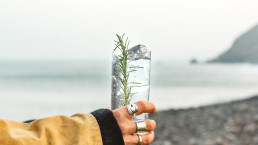
It's Healthy Too?!
Almost all the alcohol free booze companies – to differing degrees – make products that nod in the direction of healthy. Pentire drinks really ARE healthy!
There are just two calories in a standard 50ml serving and zero added sugar. So, you’re talking less than 30 calories for the entire drink if you mix it, as suggested, with a mixer-sized can of a premium Light Tonic. That’s insanely low for a drink that feels like a real treat. And Pentire is free from sulphites, vegan friendly and 100% plant-based.
Furthermore, the rock samphire included in the drinks contains vitamins C, E and K, as well as Omega 3 and antioxidants. If you didn’t already feel virtuous drinking an alcohol-free alternative to gin, you should now!
Pentire was #1 of the Top 20 Of The Best Non-Alcoholic Drinks Perfect For Dry January in British Vogue 2022
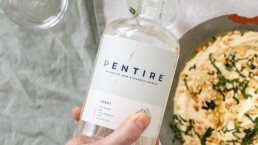
Adrift - The Original
In Pentire’s Adrift, Frosty and Ed’s passion for the coast shines through. It’s made with coastal Cornwall native botanicals that includes rock samphire, sea fennel, sage, citrus and Cornish sea salt, either sustainably sourced, foraged or organically grown. In collaboration with local botanists, distillers, and mixologists, this is the ultimate cool mixer – it’s got a kind of oceanic, rock pool, coastal walk vibe. Pour yourself a glass (we recommend a splash of tonic, a slice of lemon, or sprig of rosemary for garnish). Then picture yourself on a sandy beach —you won’t be far off.
“We’d make a Pentire Adrift and tonic to revive us on steamy days. This stuff is a natural substitute for gin, but it can also stand alone. As corny as it sounds, when we drank this concoction, we felt as if a sea breeze were washing over us. For something with such a simple ingredients list, Pentire Adrift dazzles. It’s subtly briny, and the verdant and citrusy notes—we tasted rosemary, sage, juniper, pine, and lemon — complement the salinity. Thin and lacking sugar, Pentire Adrift has the appearance of water or a clear liquor. It stands up well on its own over ice. And when Pentire Adrift is served with tonic, the result is a close dupe to a gin and tonic — and the herbal flavors still sparkle. (The company doesn’t call this an imitation gin, but Pentire Adrift does have some characteristic gin flavors.) The bottle’s chic, minimalist design makes Pentire Adrift feel especially fancy, like something you’d display on a bar cart. An extra perk: You don’t have to refrigerate this one.” – New York Times
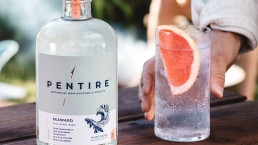
Seaward
Seaward is the second member of the Pentire family. Pentire Seaward’s bright and zesty grapefruit pith top notes blend with a hint of juniper followed by refreshing green natural tones from the Pentire Plant Blend layered with natural berry from harvested sea buckthorn, sea rosemary, and wild seaweed. Like the name Seaward suggests, each sip of this invigorating non-alcoholic spirit will magically transport you to the seaside.
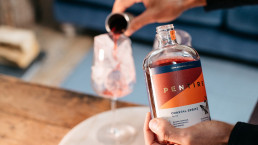
Coastal Spritz - Aperitif
Pentire has created a non-alcoholic aperitif in collaboration with the world’s best bartenders, who share Pentire’s love of the outdoors. In the Coastal Spritz, Pentire’s signature naturally distilled coastal plants are carefully blended with blood orange, sea rosemary and oakwood to create the perfect balance of natural bittersweet flavours, citrus and complex herbal tones with refreshing maritime notes. They make for fun ingredients to work with in “NO-gronis” and deliver all you want from a Negroni while reducing both the sugar and booze in the drink even further. Or the simpler aperitif version – get this over ice with a good splash of soda, and a wedge of orange and bay leaf to garnish. Delicious!
Mocktail Magic
Who doesn’t love the sound of the ice dropping into a glass and the drink gurgling onto the ice as its swirled with a cocktail spoon? With this new generation of Pentire alcohol-free drinks they can be enjoyed on their own, mixed, or made into a cocktail. While Pentire isn’t technically a gin, it’s easiest to file it under the “gin category”. And our D&N staff favourite serve is a simple Pentire & Tonic with fresh lime. The brine and herbal notes balance out the bitterness of the tonic while the citrus shines through.
But guess what, whichever way you serve your Pentire, you’ll happily sit with people consuming gin and tonics, or cocktails without feeling as if you are missing out. Here’s a few suggested mocktail recipes – have fun!
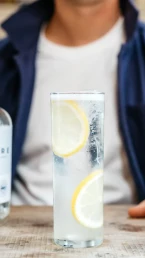
The Pentire Lemon Collins
- 50ml Pentire Adrift
- 25ml Lemon Syrup*
- Soda to taste
- 2 lemon wheels to garnish
Fill a highball glass with ice cubes, measure in the Pentire, lemon syrup and top with soda. Stir and garnish with the thin wheels of lemon.
*Lemon syrup – 200g fresh lemon juice with 400g caster sugar – Strain the lemon juice into a saucepan and bring to a gentle simmer, add the sugar, and take off the heat. Stir to dissolve and leave to cool. Bottle in a clean container, store in the fridge.
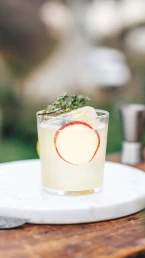
Adrift with Apple & Thyme
- 50ml Pentire Adrift
- 50ml fresh organic apple juice
- 1 Tsp raw honey
- Lemon wedge
- Splash of soda water
- Garnish -Thin slice of apple & a Sprig of thyme
Measure the Pentire Adrift, apple juice, and honey into your chosen glass. Squeeze and drop in the lemon wedge. Stir before adding ice and a splash of soda. Garnish with a thin slice of apple and a sprig of thyme.
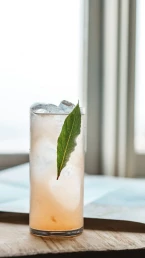
Seaward Sea Spritz
- 50ml Pentire Seaward
- 50ml fresh grapefruit juice
- 1 Tsp of honey
- Glug of soda water
- Garnish – Sprig of rosemary/ bay leaf
Measure the Pentire Adrift, apple juice, and honey into your chosen glass. Squeeze and drop in the lemon wedge. Stir before adding ice and a splash of soda. Garnish with a thin slice of apple and a sprig of thyme.
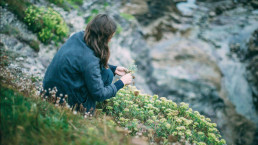
No Greenwashing Here! Ethics & Sustainability
In addition to a great-tasting liquid, Pentire is a seriously cool company.
Firstly, they’ve got the business model sorted – they are certified B-Corp. So, what does that really mean? “Certified B Corporations are businesses that meet the highest standards of verified social and environmental performance, public transparency, and legal accountability to balance profit and purpose. B Corps are accelerating a global culture shift to redefine success in business and build a more inclusive and sustainable economy.”
In short, this company is committed to creating a business culture grounded in ethical behaviour in every respect. They use organic, Fair Trade ingredients. Packaging is recycled and recyclable, as well as purchasing carbon offsets for their packaging and shipping. The company also donates to charities with a percentage of profits from every bottle going to the Blue Marine Foundation for ocean preservation. That’s lots of meaningful big ticks right there.
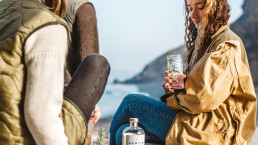
So, Who're Pentire’s Non-Alcoholic Drinks For?
You may choose a non-alcoholic drink for a host of reasons, whether you’re sober, avoiding alcohol for medical or religious reasons, pregnant, driving home, moderating your alcohol intake, or just wanting to avoid a hangover. Or you may just want a delicious and interesting beverage – PENTIRE is it! #drinkfortomorrow #trysomethingnew
From the branding to the taste to the health benefits to the ethics, PENTIRE is a range of drinks with a serious feel-good factor. This is a classy range that everyone should be buying to add to your growing “booze free bar” at home. Cheers to that!
Library Release: From Our Very Own Unrelenting Artisan, Folium
Library Release:
From Dhall & Nash’s very own ‘Unrelenting Artisan’
- Folium Vineyard
In the vast landscape of Marlborough wine, owning and drinking one of Folium’s meticulously aged gems is always a privilege and an opportunity not to be missed!
Generously, owner-winemaker extraordinaire, Takaki Okada, has made available to Dhall and Nash a limited number of 2013 Folium Reserve Sauvignon Blanc and 2012 Folium Reserve Pinot Noir.
Folium Vineyard’s Takaki Okada has been crafting supremely elegant & complex vinous jewels for more than 10 years. As you Folium fans already know, Takaki is a Japanese winemaker, who reveres the intricacies of French old-world wines and with his American wine schooling he cleverly wrests magical liquid from his Brancott Valley vines. This is not your everyday garden variety Marlborough savvy or pinot!
Not only is Takaki Okada an immensely likeable character – a one-man band doing everything by hand – he is also a meticulous, obsessive, and a detail-oriented passion-driven perfectionist. And rather witty to boot!
Exciting doesn’t adequately describe this wine release. Neither does riveting. This is certifiably enthralling, bewitching stuff. Imagine, if you can, your next Folium wine purchases have been lovingly cloistered in perfect cellar conditions for your tasting pleasure now.
Purity. Elegance. Depth. Persistence.
2013 Folium Sauvignon Blanc Reserve
“Fine with some wax and nuts as well as subtle hints of toffee covering the sweet pear and citrus fruit. Rounded with some richness, this is very stylish and distinctive.”
92/100 Points – Dr Jamie Goode, Wine Anorak
“Dry-farmed, high-density vineyard. 8-9 months on lees to counterbalance the high acidity. Complex mix of citrus, spice, celery, and saline. Finely textured, dry, taut, and really elegant. Mouth-watering freshness.”
17.5/20 Points – Julia Harding M.W., Jancis Robinson.com
“Hand-picked fruit, from vines planted in 1996, on clay soil, WBP and fermented at up to 20°C to 14.0% alc., the wine aged up to 8 months on lees. Bright, even straw-yellow colour with slight green hues. The nose is very fresh with vibrant and concentrated aromas of thirst-quenching white stone fruits, herbs, and gooseberries, along with complexing tropical fruit detail. Dry to taste and medium-full bodied, this has a fulsome mouthfeel with restrained flavour expression. Pure white stone fruits, gooseberries, herbs, and ripe tropical fruit flavours exude a subtle sweetness and richness, building in depth. The fruit is balanced by softly refreshing, lively, ripe acidity, and is carried with good drive to a long, positive, minerally finish. This Sauvignon Blanc has a subtle richness and presence, with pure stone fruit and herb flavours that will become more complex over the next 2-3 years.”
18.5-/20 Points – Raymond Chan Wine Reviews Sept 2014
2012 Folium Pinot Noir Reserve
“Medium ruby-purple in color and filled with aromas of warm mulberries, kirsch and blackberry compote with hints of allspice, cloves and mushrooms. The2012 Folium Reserve PN is a light to medium-bodied wine offering delicate flavours and a silky texture. It finishes with good length.”
90/100 Points – Lisa Perotti-Brown, Robert Parker’s The Wine Advocate
“Lovely cherry and plum fruit with a hint of sweet and sour. Linear and focused with nice brightness. Supple and drinkable.”
91/100 Points – Dr Jamie Goode, Wine Anorak
“… this fresh and elegant unfiltered pinot noir has aged beautifully thanks to its bright track of acidity, a gift from the vintage. Concentrated, complex and long with delicious savoury mature pinot character developing, this is a gem.”
The Wine Society
“Dark, deep, ruby-red colour with youthful purple hues. The bouquet is soft, refined and gently concentrated with aromas of ripe dark raspberry and black cherry fruit harmoniously integrated with notes of raspberry liqueur, black florals, and spices. Funky game and earthy elements emerge with aeration. Medium-bodied, soft, and plush fruit flavours of dark red berry and cherry fruit are melded with spice and earthy game notes. Some earthy nuances add complexity and interest. The palate has a concentrated core, and the mouthfeel features fine-grained tannins that grow, with piquant acidity providing tension and freshness. The wine carries to a fine-textured, dry and elegant finish. This is a soft, gently luscious, fine-textured Pinot Noir with good freshness and dark fruit flavours with a little funky, earthy complexity. Hand-picked fruit destemmed, given a cold soak and indigenous yeast fermented to 13.86% alc., the wine aged in 25% new French oak barrels.”
18.0/20 Points – Raymond Chan Wine Reviews June 2014
These painstakingly handmade wines whose beauty and delicacy are exquisitely revealed after years of aging are ready to be unveiled now!
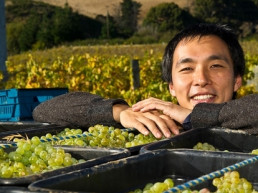
Folium Vineyards celebrated it’s 10th Anniversary in 2021, Take a look here if you want to learn more about the history of this heartwarmingly boutique kiwi winery.
For orders please email us at orders@dnfinewine.com.
Les Merveilleux Producteurs: A Natural Wine-Matched Dinner
Last month we hosted an exclusive natural wine-matched dinner at Ponsonby’s daring restaurant, Orphans Kitchen. We enjoyed four divine courses alongside a selection of the finest natural, biodynamic and organic wines from our portfolio including a De Martino Viejas Tinajas Muscat, Denavolo Dinavolo Vino da Tavolo Orange Wine, La Stoppa Trebbiolo Rosso, and the star of the evening – the 2016 Domaine des Pothiers La Chapelle. The wines had a chance to shine alongside a goose rillette with warm baguette, beef rib roast, and assorted canapes and cheese, making the evening a sensory experience of the highest order that natural wine lovers did not want to miss.
Check out some of our favourite photos from the event below:
Introducing "Les Merveilleux Producteurs"
An introduction to Natural, Organic & Biodynamic Wine
At Dhall & Nash, we have the following set of core values that we would like to share with you:
We respect those who create wonders, by patiently loving, toiling and knowing their small piece of earth through the generations. We passionately believe in building a bridge by education and experience - so that you may better appreciate and indulge in these wonders that you so well deserve.
Our current campaign, which includes plenty of tasting and eating, is all about celebrating these values by showcasing some of the wonderful growers and producers that we work with, and shining a spotlight on the vin nature side of things.
Les Merveilleux Producteurs!
So, let us start briefly with a little bit of history around wine culture. When considering the making of wine, one has to begin at the heart of it all, which is the grapes; it’s all about the fruit. Winegrowing is essentially a form of agriculture. In many parts of the world winegrowers would cultivate wheat, beans, chickpeas, even fruit trees and other vegetables between the rows of their vines in order to create biodiversity on their land and feed their families. In the 20th century, modern agriculture changed everything and went through a process that mechanised and simplified farming in an attempt to increase yields and maximize short term profits. Grape-growing, like the rest of agriculture, is no exception and the wine industry followed in this industrialised pursuit. One of the biggest issues around this disconnection to the land is the development of synthetic chemical treatments, which we know has a detrimental effect on soil life and leads to degradation and soil erosion. Like so many other industries, wine moved from being handmade and artisanal to being large-scale and industrialised. Advances in technology and winemaking science have been enormously positive for the industry as a whole; however, a movement has risen that agrees we seem to have lost some perspective.
What is Natural Wine?
This is a commonly used term to describe wines made from vineyards that are farmed organically and/or biodynamically at the very least, and which are produced without adding or removing anything during vinification, apart from a dash of sulphites at most at bottling.
This is a simple, yet precise definition that considers both the growing and making decisions that goes into producing wine. The term natural in itself is a bit polarizing - live, pure, raw, real, true, low-intervention, authentic, farmhouse, are all alternatives and a little less contentious, however, as per Isabelle Legeron MW in her book 'Natural Wine', the word natural seems to be the broadly used term across the globe to describe healthily grown, nature friendly, low intervention wines that truly express their place of origin.
All in all, natural wine accounts for a very small proportion of the wine world, but over the last several years these wine styles are being rediscovered and celebrated worldwide by the wine industry and consumers alike.
For these growers, what they do goes well beyond the wine itself; it is also a philosophy, a way of life, which undoubtedly contributes to its profound appeal to people across the globe.
This philosophy was on show late last year, when Wellington hosted the 2nd Budburst Natural Wine Festival in New Zealand. As part of the organising committee, one of the main principles the event was based on was: wine starts in the vineyard. The festival members believe that natural wine cannot be made from conventionally farmed fruit – producers were asked to verify that they grow their grapes organically or biodynamically before submitting their wines for the event.
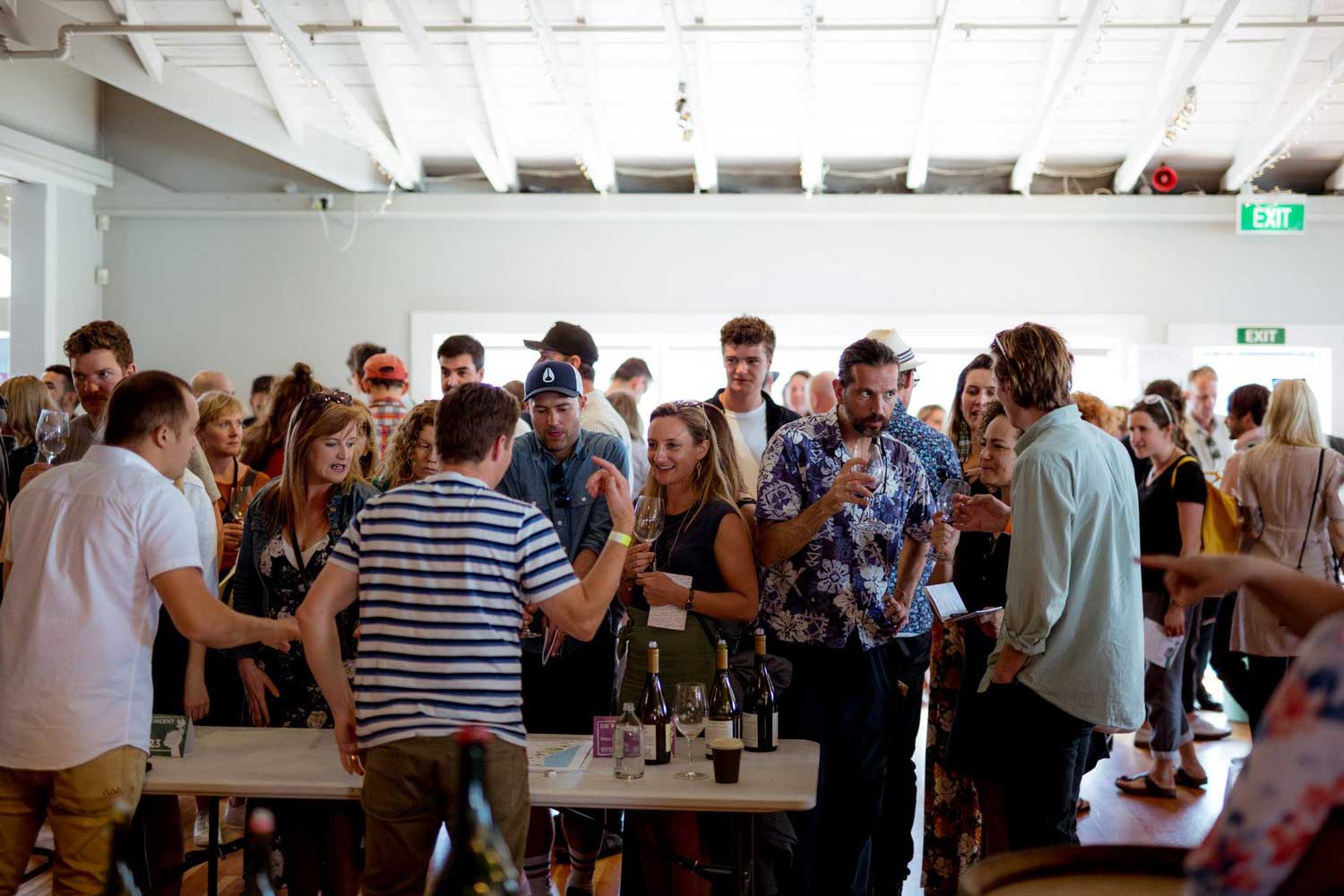
What is Organic and Biodynamic Farming?
Organic farming aims to avoid synthetic chemicals in the vineyard, including the use of pesticides, herbicides, fungicides and synthetic fertilizer. In place, plant and mineral based products are used to work against pests and diseases and to increase the health of soils and build up plant immunity and nutrient uptake.
Biodynamic farming is a form of organic cultivation developed by the Austrian anthroposophist Rudolf Steiner in the 1920’s. It is based on traditional practices; whereby polyculture and animal husbandry are at the heart of the farm. Unlike organics, the emphasis of biodynamics is on prevention rather than treatment, as well as encouraging the self-sufficiency of the farm unit. Natural preparations based on plants, minerals and manures are used in combination with astronomy to stimulate microbial life, boost the immune systems of plants and improve soil fertility.
To best illustrate these farming philosophies, we have put together a marvellous line-up of twelve wines from the Dhall & Nash portfolio including styles from the USA, France, New Zealand, Chile & Italy. Not all of these wines were chosen because they are made naturally in particular, in some cases they are not or not intended to be framed that way, but are farmed using all or some of these methods and exemplify their makers intentions and decisions for their land. This is a celebration and nod to the wonderful growers - Les Merveilleux Producteurs!
Expect a sensory experience of the highest order starting from fresh, saline and mineral, into an aromatic dual between two skin contact heavyweights. Then we taste spice, volume and history as we the hit the first set of red wines, moving into a marvellous combination of pioneering spirit and benchmark terroir, concluding with a love story, ancient soil and what does wine taste like living on the edge.
The Wines
Flight 1
2016 Causse Marines Les Grielles
2015 Folium Vineyard Reserve Sauvignon Blanc
2016 Domaine Vincent Careme Le Clos
Flight 2
2016 De Martino Viejas Tinajas Muscat
2015 Denavolo Dinavolo Vino da Tavola Orange Wine
Flight 3
2016 Aurum Madeleine Pinot Noir
2016 Easthope Family Winegrowers Gamay Noir
2016 Domaine des Pothiers La Chapelle
Flight 4
2015 Domaine de Noire Elegance
2015 Domaine Magdalena Red Mountain Cabernet Sauvignon
Flight 5
2015 La Stoppa Trebbiolo Rosso
2013 Ambyth Estate Grenache
